
Classic Stock // Getty Images
By Caroline Delbert
Weather is global, meaning what is seen in an American summer is often reflected or complemented by the rest of the world. Even recurring El Nino and La Nina phenomena begin in the ocean and ripple out to affect the entire world’s weather, sometimes for years at a time.
Within the United States, these global forces could mean extreme weather on the coasts while the Midwest is unscathed. It could mean heavy rain and cold temperatures in the entire country for that whole summer, with consequences for everything from agriculture to tourism. Understanding these trends is interesting even as trivia, but weather events shape what happens to people in both direct and indirect ways that are worth considering.
To illustrate what summer weather was like from 1920 to 2020, Stacker consulted data from the National Oceanic and Atmospheric Administration (NOAA). The average, maximum, and minimum temperatures and average precipitation data for each year was gathered from the NOAA’s Time Series database. Summer is defined as the months of June, July, and August.you
What was the weather like for your very first summer? Take a look, and you may remember more than you think—or learn something new about a summer before your time.
You may also like: Fastest-warming cities in the U.S.

Leemage/Corbis Historical // Getty Images
1920: Cold and hot in Russia
– Average summer temperature: 70.2 F (#96 warmest year; 1.6% below 100-year average)
– Maximum summer temperature: 83.1 F (#92 warmest year; 1.5% below 100-year average)
– Minimum summer temperature: 57.3 F (#95 warmest year; 1.8% below 100-year average)
– Precipitation: 9 inches (#18 highest; 8.1% above 100-year average)
If you happened to be born in the western portion of what’s Russia today, you experienced the most out-of-character hot summer temperatures in the Northern Hemisphere in 1920. And if you were born in the easternmost portion of Russia, you experienced the coldest extreme summer temperatures.
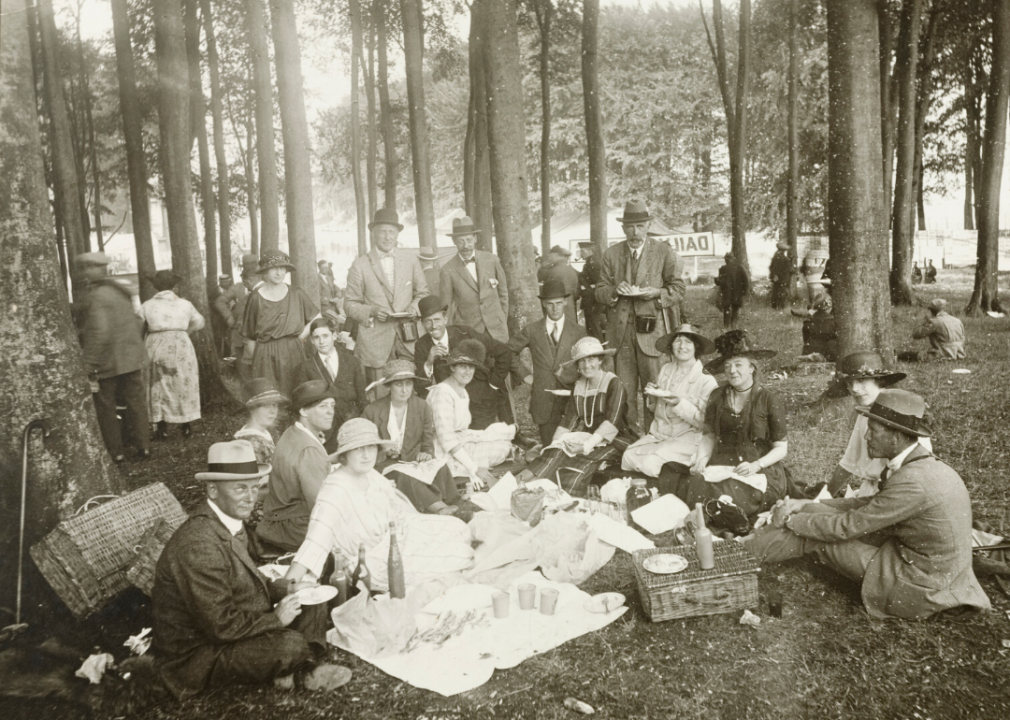
Bristol Archives/Universal Images Group // Getty Images
1921: Highs and lows in North America
– Average summer temperature: 72.4 F (#25 warmest year; 1.3% above 100-year average)
– Maximum summer temperature: 85.2 F (#31 warmest year; 1% above 100-year average)
– Minimum summer temperature: 59.5 F (#21 warmest year; 1.8% above 100-year average)
– Precipitation: 8.4 inches (#53 highest; 0.5% above 100-year average)
In the summer of 1921, the most extreme cold summer temperature was in the Canadian Maritimes—New Brunswick, Nova Scotia, and Prince Edward Island. Some of the proportionally hottest temperatures were less than 1,000 miles away in the U.S. Midwest.

ullstein bild Dtl. // Getty Images
1922: An extreme drought in Minnesota
– Average summer temperature: 72 F (#40 warmest year; 0.8% above 100-year average)
– Maximum summer temperature: 85.2 F (#32 warmest year; 0.9% above 100-year average)
– Minimum summer temperature: 58.8 F (#49 warmest year; 0.7% above 100-year average)
– Precipitation: 7.8 inches (#78 highest; 6% below 100-year average)
Minnesota and New Mexico both experienced extreme droughts in the summer of 1922, even before the Dust Bowl droughts that blanketed the country in the years to come. The most anomalous cold and hot temperatures were close together again, in northern Canada and the furthest eastern portion of Russia.
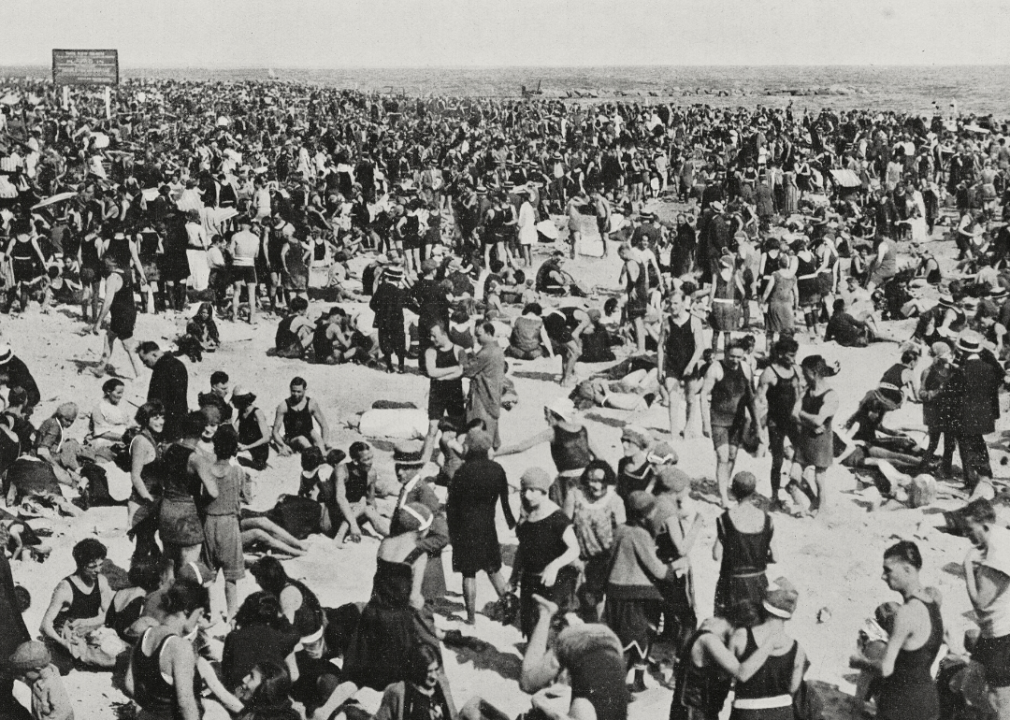
De Agostino Picture/Library // Getty Images
1923: Heavy rain in the breadbasket
– Average summer temperature: 71 F (#80 warmest year; 0.6% below 100-year average)
– Maximum summer temperature: 83.6 F (#83 warmest year; 1% below 100-year average)
– Minimum summer temperature: 58.4 F (#68 warmest year; 0.1% below 100-year average)
– Precipitation: 8.9 inches (#21 highest; 7.2% above 100-year average)
In 1923, America’s breadbasket—often considered most of the Great Plains states or the Midwest—experienced torrential amounts of precipitation all summer. The coldest anomalous summer was in western Europe, and the warmest anomalous summer was in Russia.
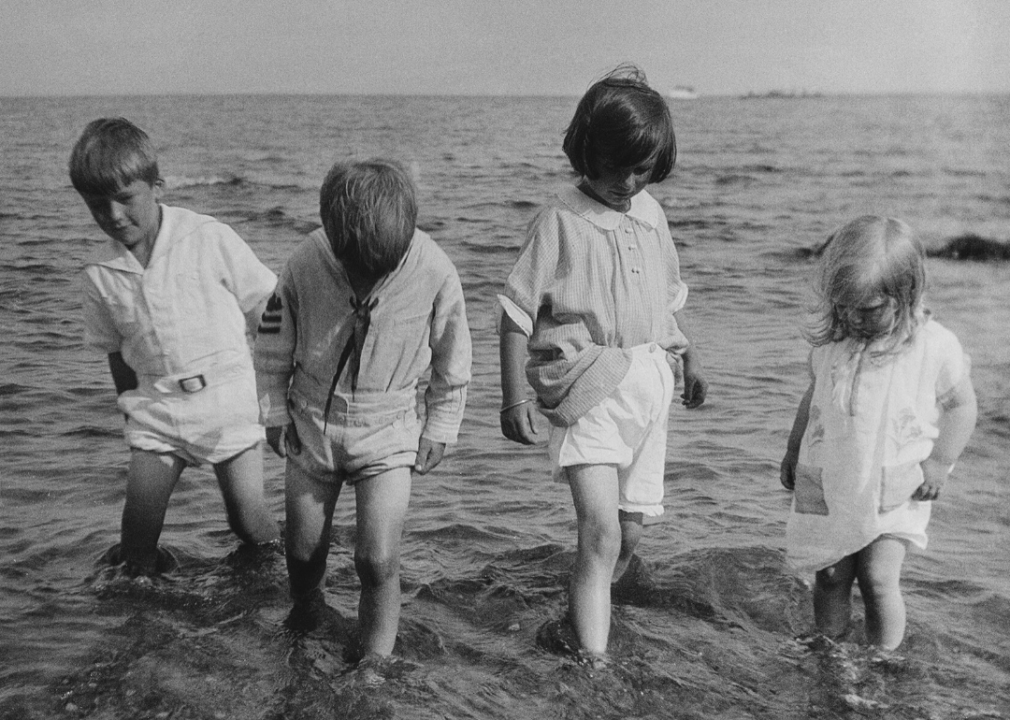
The Montefraulo Collection/Hulton Archive // Getty Images
1924: An extreme drought in the West
– Average summer temperature: 70.9 F (#83 warmest year; 0.8% below 100-year average)
– Maximum summer temperature: 84.4 F (#65 warmest year; 0% below 100-year average)
– Minimum summer temperature: 57.3 F (#97 warmest year; 1.9% below 100-year average)
– Precipitation: 7.4 inches (#89 highest; 11.7% below 100-year average)
A severe drought encompassed the western United States in the summer of 1924, growing more severe from May through September. The most abnormal cold summer temperatures were once again in the Canadian Maritimes.
You may also like: 10 ways nature and animals forecast the weather
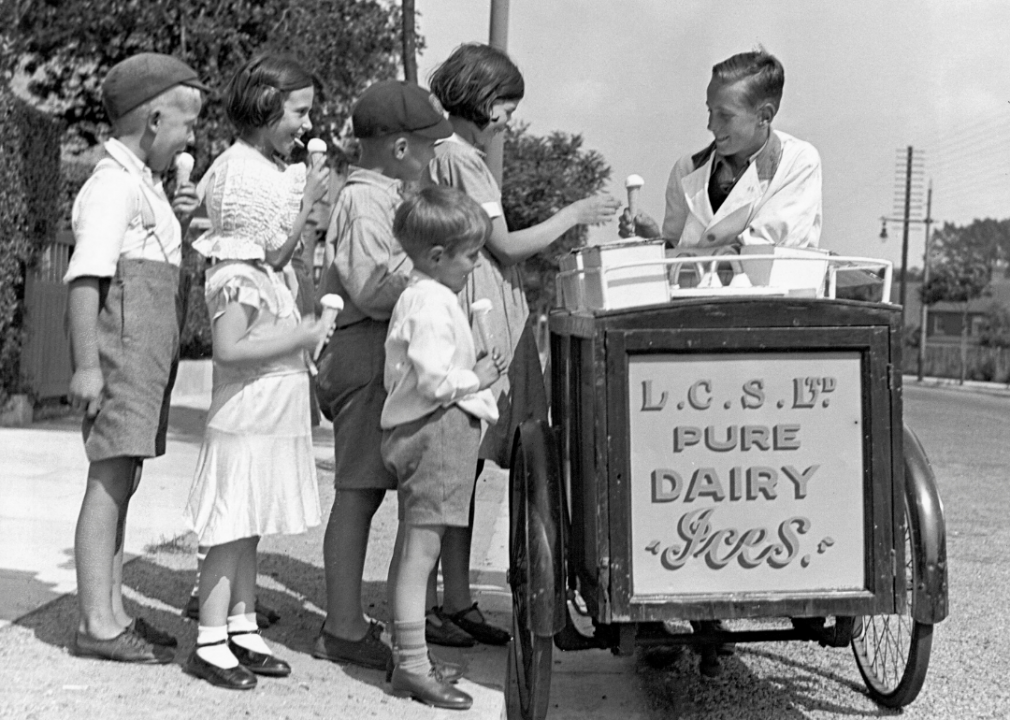
Science & Society Picture Library // Getty Images
1925: A dry summer in the South
– Average summer temperature: 71.8 F (#53 warmest year; 0.5% above 100-year average)
– Maximum summer temperature: 85 F (#39 warmest year; 0.8% above 100-year average)
– Minimum summer temperature: 58.6 F (#60 warmest year; 0.3% above 100-year average)
– Precipitation: 7.6 inches (#81 highest; 8.4% below 100-year average)
The southern United States experienced an escalating drought during the summer of 1925. The most anomalously cold temperatures were recorded in the Canadian Maritimes.

ullstein bild Dtl. // Getty Images
1926: A dry Pacific Northwest
– Average summer temperature: 71.3 F (#65 warmest year; 0.1% below 100-year average)
– Maximum summer temperature: 84.6 F (#57 warmest year; 0.2% above 100-year average)
– Minimum summer temperature: 58 F (#81 warmest year; 0.7% below 100-year average)
– Precipitation: 8.6 inches (#43 highest; 3% above 100-year average)
Different areas in the Pacific Northwest experienced drought during the summer of 1926. The same year, the most unseasonably warm summer temperatures were reported in northern China and Mongolia.
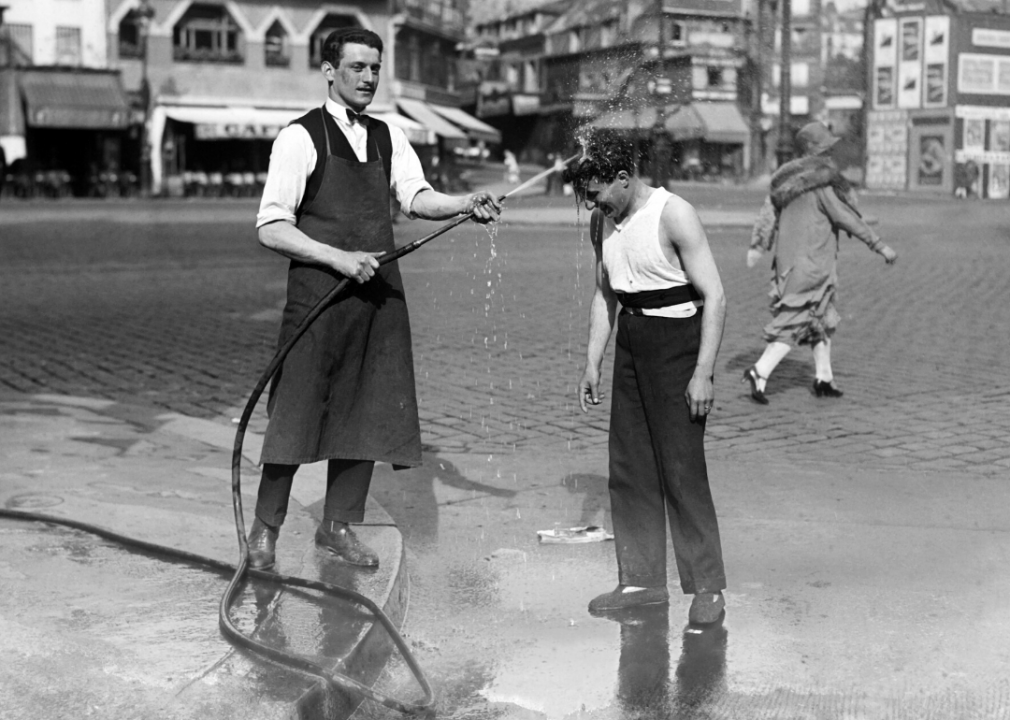
Keystone France/Gamma Keystone // Getty Images
1927: A rainy summer
– Average summer temperature: 69.8 F (#98 warmest year; 2.3% below 100-year average)
– Maximum summer temperature: 82.5 F (#99 warmest year; 2.3% below 100-year average)
– Minimum summer temperature: 57 F (#99 warmest year; 2.4% below 100-year average)
– Precipitation: 8.7 inches (#35 highest; 4.3% above 100-year average)
Areas of states in the upper South, like Missouri and southern Illinois, experienced heavy rainfall that also affected the far Midwest like Montana and North Dakota. And, once again, the Canadian Maritimes experienced the most disproportionately cold summer temperatures.
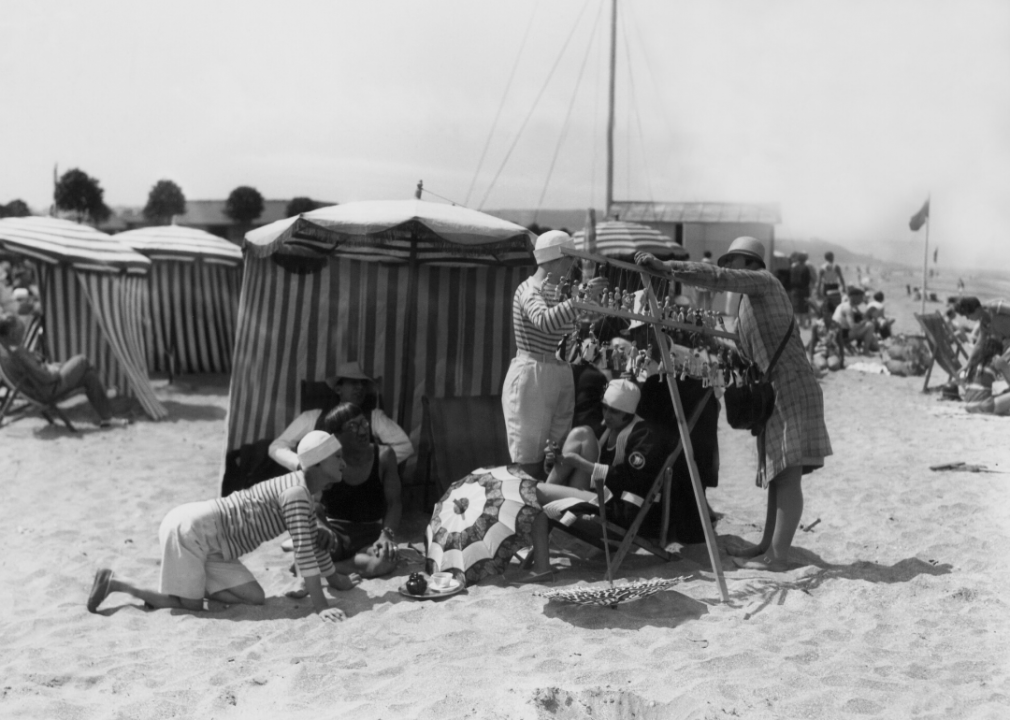
Keystone France/Gamma Keystone // Getty Images
1928: The Okeechobee hurricane
– Average summer temperature: 70.4 F (#94 warmest year; 1.4% below 100-year average)
– Maximum summer temperature: 83 F (#93 warmest year; 1.7% below 100-year average)
– Minimum summer temperature: 57.8 F (#88 warmest year; 1.1% below 100-year average)
– Precipitation: 10.5 inches (#1 highest; 26.2% above 100-year average)
The deadly Okeechobee hurricane of 1928 killed an estimated 4,000 people in the Caribbean and Florida. The Category 5 hurricane struck in September following a colder than average summer. The highest average precipitation—10.5 inches—occured this summer as well.
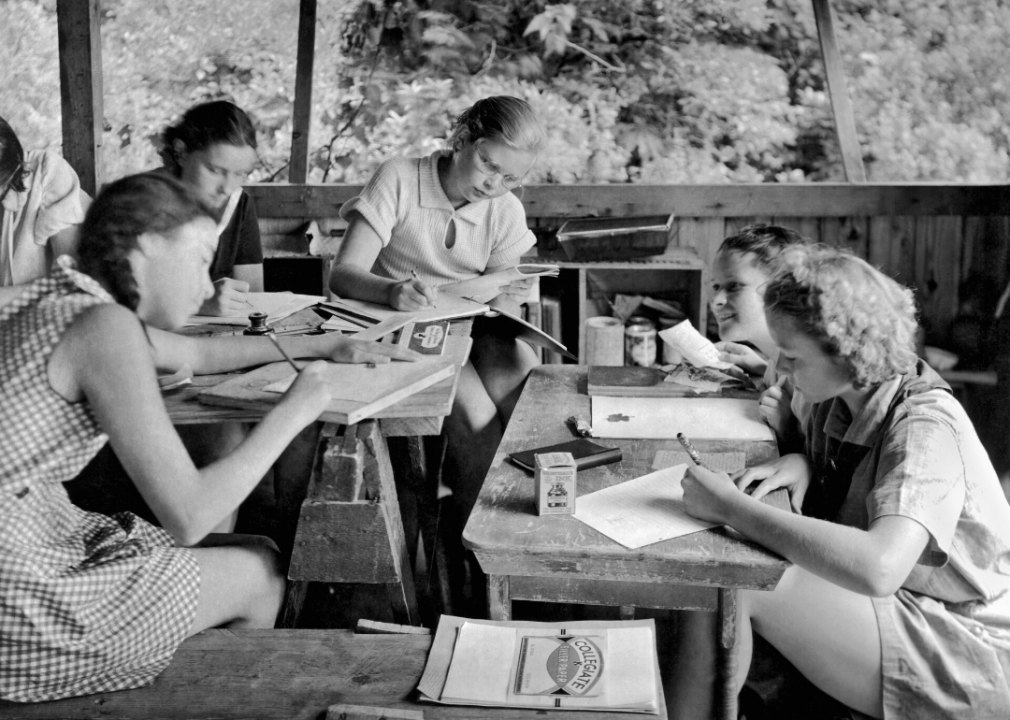
Underwood Archives // Getty Images
1929: A wave of Pacific drought
– Average summer temperature: 71.2 F (#70 warmest year; 0.2% below 100-year average)
– Maximum summer temperature: 84.7 F (#49 warmest year; 0.4% above 100-year average)
– Minimum summer temperature: 57.8 F (#89 warmest year; 1.1% below 100-year average)
– Precipitation: 7 inches (#95 highest; 15.9% below 100-year average)
A drought of varying intensity affected the entire Pacific coast during the summer of 1929. Otherwise, temperatures were low-average across the United States.
You may also like: 15 ways to stay cool in the summer
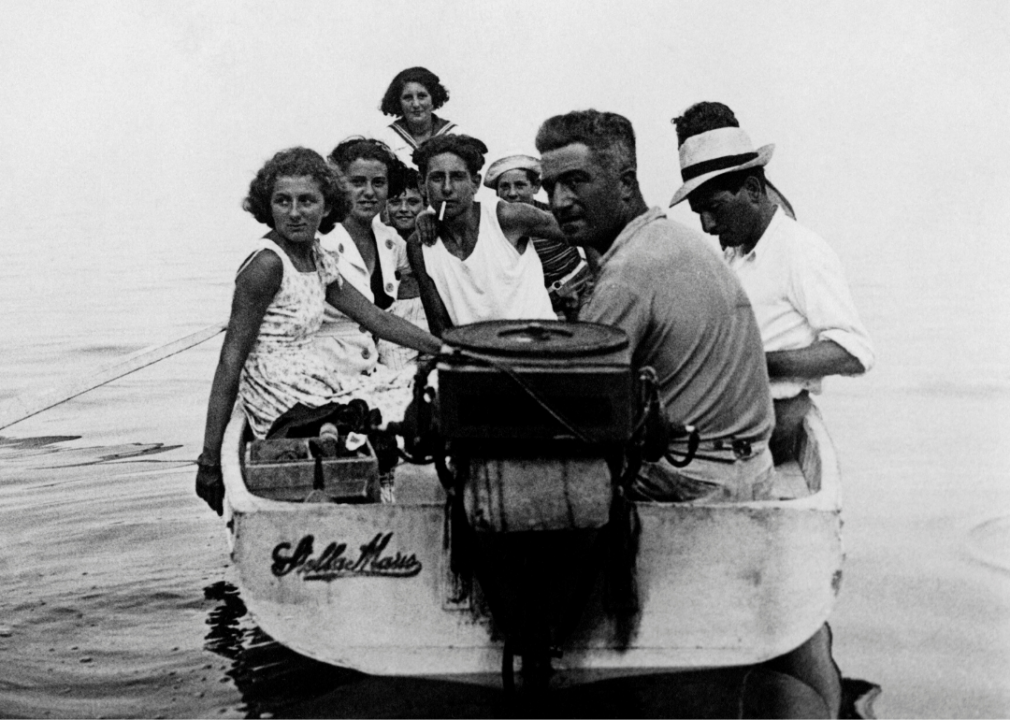
Marka/Universal Images Group // Getty Images
1930: A dry Midwestern summer
– Average summer temperature: 72.1 F (#34 warmest year; 1% above 100-year average)
– Maximum summer temperature: 85.9 F (#14 warmest year; 1.8% above 100-year average)
– Minimum summer temperature: 58.3 F (#71 warmest year; 0.2% below 100-year average)
– Precipitation: 6.1 inches (#100 highest; 26.9% below 100-year average)
An escalating drought affected a wide swath of the Midwest from southern Illinois through Kentucky and all the way to Virginia and West Virginia. This continued to spread and grow through the winter.
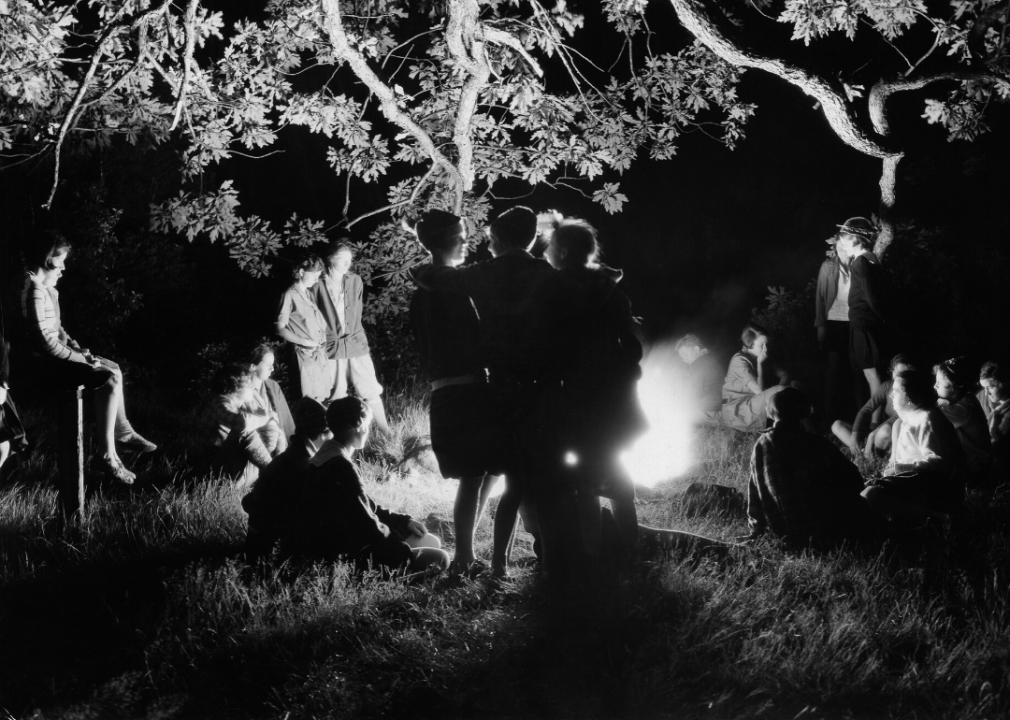
ullstein bild Dtl. // Getty Images
1931: A warm, dry summer
– Average summer temperature: 72.8 F (#13 warmest year; 2% above 100-year average)
– Maximum summer temperature: 86.3 F (#8 warmest year; 2.3% above 100-year average)
– Minimum summer temperature: 59.3 F (#26 warmest year; 1.6% above 100-year average)
– Precipitation: 7.6 inches (#82 highest; 9% below 100-year average)
During a warmer than average year, many parts of the United States experienced drought that worsened during the summer. And of all places, Greenland experienced a disproportionately warm summer along with Europe and the United States.
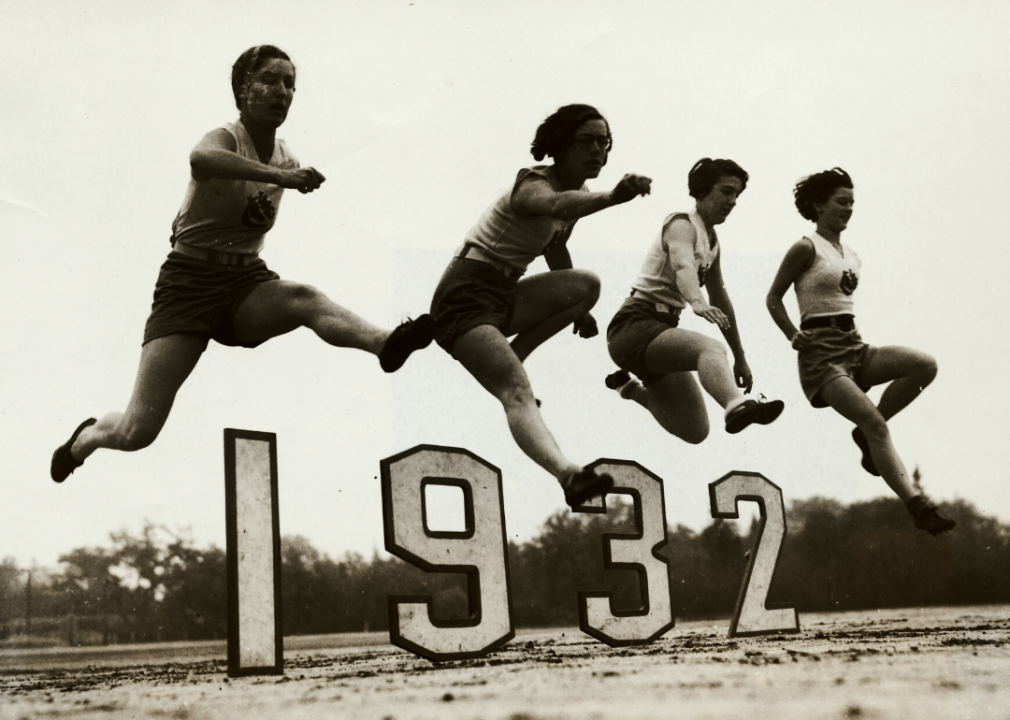
George Rinhart/Corbis Historical // Getty Images
1932: A wet summer in the Southwest
– Average summer temperature: 72 F (#42 warmest year; 0.8% above 100-year average)
– Maximum summer temperature: 85.1 F (#37 warmest year; 0.8% above 100-year average)
– Minimum summer temperature: 58.8 F (#47 warmest year; 0.7% above 100-year average)
– Precipitation: 8.5 inches (#48 highest; 2.3% above 100-year average)
During an average temperature year, the Caribbean experienced the most anomalously cold summer temperatures. The American Southwest had an especially wet season with much higher than average precipitation through the summer.
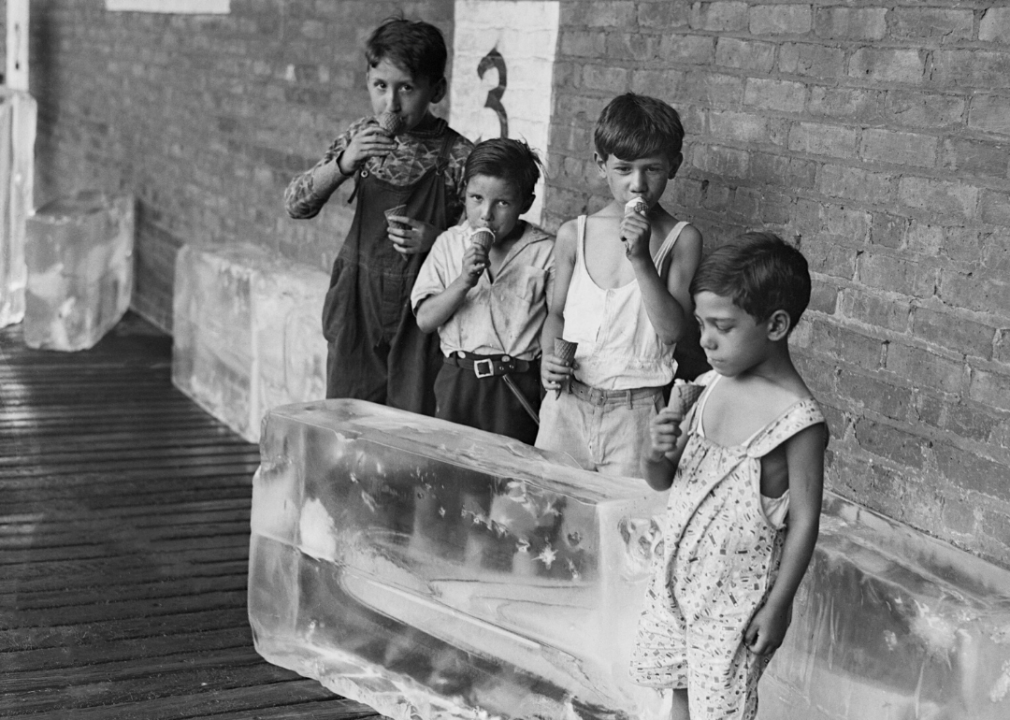
Bettman // Getty Images
1933: A warm, very dry summer
– Average summer temperature: 72.9 F (#12 warmest year; 2% above 100-year average)
– Maximum summer temperature: 86.6 F (#7 warmest year; 2.6% above 100-year average)
– Minimum summer temperature: 59.2 F (#33 warmest year; 1.3% above 100-year average)
– Precipitation: 7.1 inches (#93 highest; 14.2% below 100-year average)
Average temperatures throughout 1933 were warmer than usual. That corresponded with widespread, but still mostly moderate drought conditions, across the entire swath of the U.S. Midwest.

H. Armstrong Roberts/ClassicStock // Getty Images
1934: The Central America hurricane
– Average summer temperature: 73.5 F (#4 warmest year; 3% above 100-year average)
– Maximum summer temperature: 87.3 F (#2 warmest year; 3.5% above 100-year average)
– Minimum summer temperature: 59.7 F (#18 warmest year; 2.3% above 100-year average)
– Precipitation: 6.9 inches (#96 highest; 16.8% below 100-year average)
In June of 1934, one of the warmest years of the century, what was called simply the Central America hurricane struck there as well as the Caribbean and the southern United States. It was just Category 2, but caused up to 2,000 deaths after extensive flooding. This compounded the devastating effects of widespread extreme drought in the United States.
You may also like: Why does lightning strike? And answers to 50 other weather questions
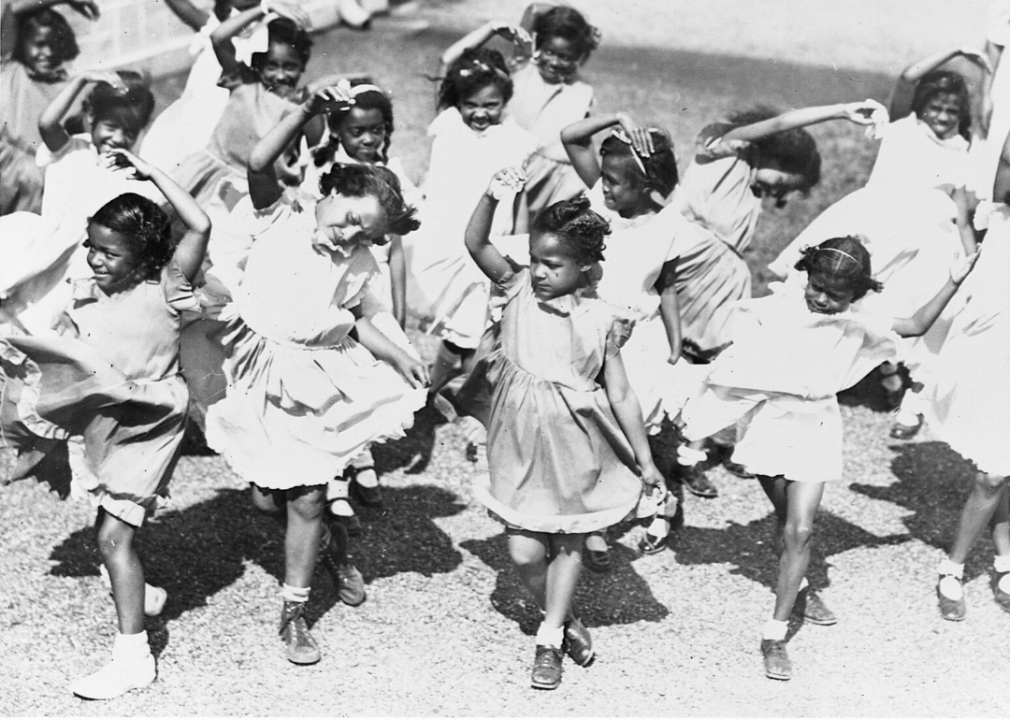
Minnesota Historical Society/CORBIS/Corbis via Getty Images
1935: Tropical storm Labor Day
– Average summer temperature: 71.9 F (#45 warmest year; 0.7% above 100-year average)
– Maximum summer temperature: 85 F (#41 warmest year; 0.7% above 100-year average)
– Minimum summer temperature: 58.9 F (#44 warmest year; 0.8% above 100-year average)
– Precipitation: 8.3 inches (#55 highest; 0.2% below 100-year average)
Hurricane season begins in June, but peaks in September, and in 1935, the northern Atlantic was slammed by the worst hurricane on record at the time. Florida experienced the most damage. The storm hit the Florida Keys as a Category 5 hurricane, traveled northward along the west coast of Florida and then continued northeastward across the southeastern U.S. states.
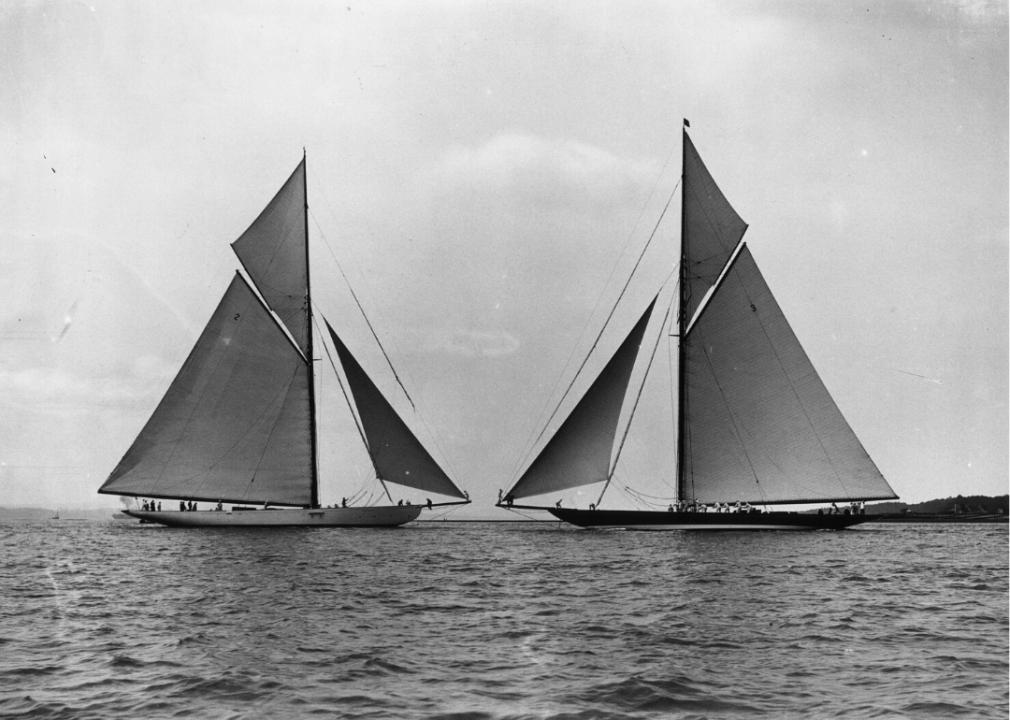
Central Press/Hulton Archive // Getty Images
1936: An extremely hot summer
– Average summer temperature: 74 F (#1 warmest year; 3.6% above 100-year average)
– Maximum summer temperature: 87.9 F (#1 warmest year; 4.2% above 100-year average)
– Minimum summer temperature: 60.1 F (#11 warmest year; 2.8% above 100-year average)
– Precipitation: 6.4 inches (#99 highest; 22.7% below 100-year average)
This extremely warm year corresponded with an equally hot summer. The United States experienced rare warm summer temperatures and widespread drought in the Midwest and Pacific Northwest.
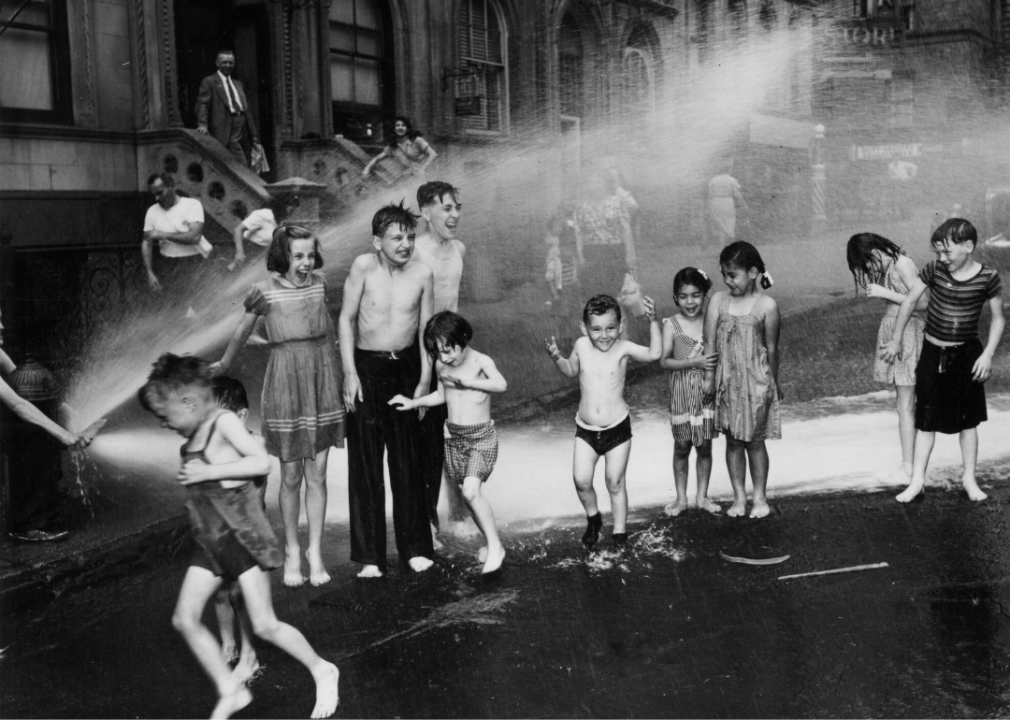
Weegee(Arthur Fellig)/International Center of Photography // Getty Images
1937: A warm, dry Midwestern summer
– Average summer temperature: 72.7 F (#17 warmest year; 1.8% above 100-year average)
– Maximum summer temperature: 85.8 F (#15 warmest year; 1.7% above 100-year average)
– Minimum summer temperature: 59.5 F (#19 warmest year; 1.9% above 100-year average)
– Precipitation: 8.3 inches (#59 highest; 0.5% below 100-year average)
The United States experienced a warmer than average year. In the summer, hot temperatures with some drought conditions in the Midwest were bookended by anomalously cold weather in both the Canadian Maritimes and the Caribbean.

CORBIS/Corbis via Getty Images
1938: An average summer
– Average summer temperature: 72.1 F (#35 warmest year; 1% above 100-year average)
– Maximum summer temperature: 85.2 F (#32 warmest year; 0.9% above 100-year average)
– Minimum summer temperature: 59 F (#42 warmest year; 1% above 100-year average)
– Precipitation: 8.5 inches (#47 highest; 2.4% above 100-year average)
The summer of 1938 was the middle of a sandwich of very average temperatures in the United States. In contrast, the disproportionately hot summer temperatures were in Europe, including Scandinavia and the western portion of Russia.

Fred Morley/Hulton Archive // Getty Images
1939: A dry summer in the breadbasket
– Average summer temperature: 72.1 F (#33 warmest year; 1% above 100-year average)
– Maximum summer temperature: 85.5 F (#18 warmest year; 1.3% above 100-year average)
– Minimum summer temperature: 58.7 F (#52 warmest year; 0.5% above 100-year average)
– Precipitation: 8.4 inches (#50 highest; 0.8% above 100-year average)
Although the temperatures were warmer than average, the summer of 1939 wasn’t exceptionally hot. There were some severe drought conditions in parts of the breadbasket and upper Midwest.
You may also like: The best streaming services in 2021
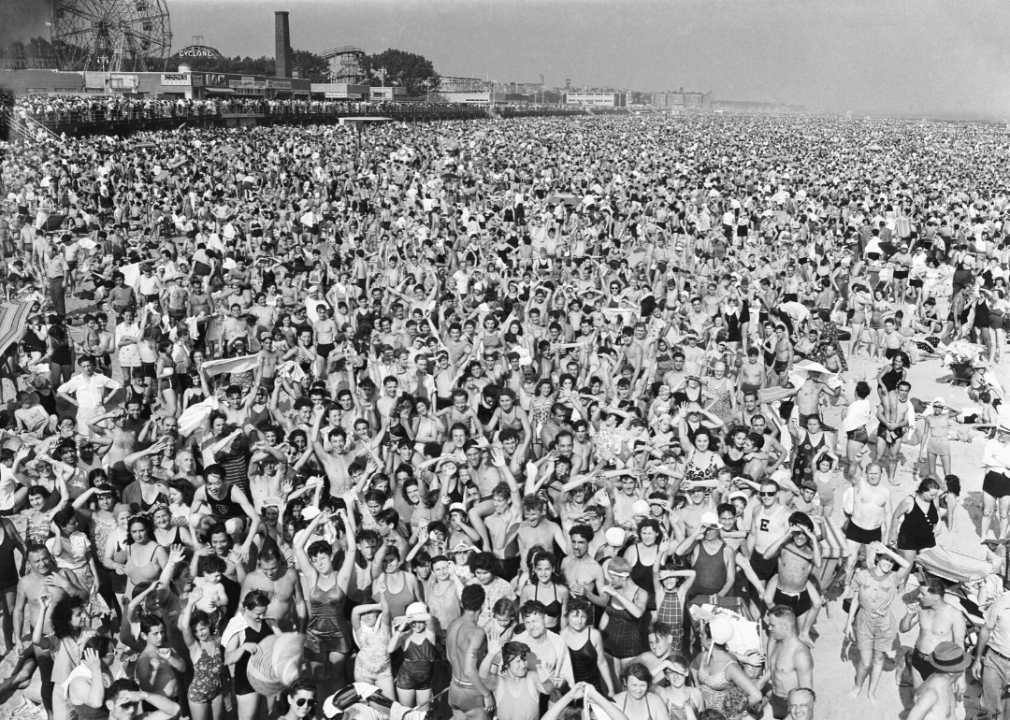
Kirn Vintage Stock/Corbis via Getty Images
1940: Drought in the Midwest
– Average summer temperature: 72 F (#43 warmest year; 0.8% above 100-year average)
– Maximum summer temperature: 85.3 F (#27 warmest year; 1% above 100-year average)
– Minimum summer temperature: 58.6 F (#57 warmest year; 0.4% above 100-year average)
– Precipitation: 8.5 inches (#49 highest; 1.6% above 100-year average)
In 1940, temperatures around the United States were just about average overall. In the Midwest, drought conditions were concentrated in Kansas and Nebraska.
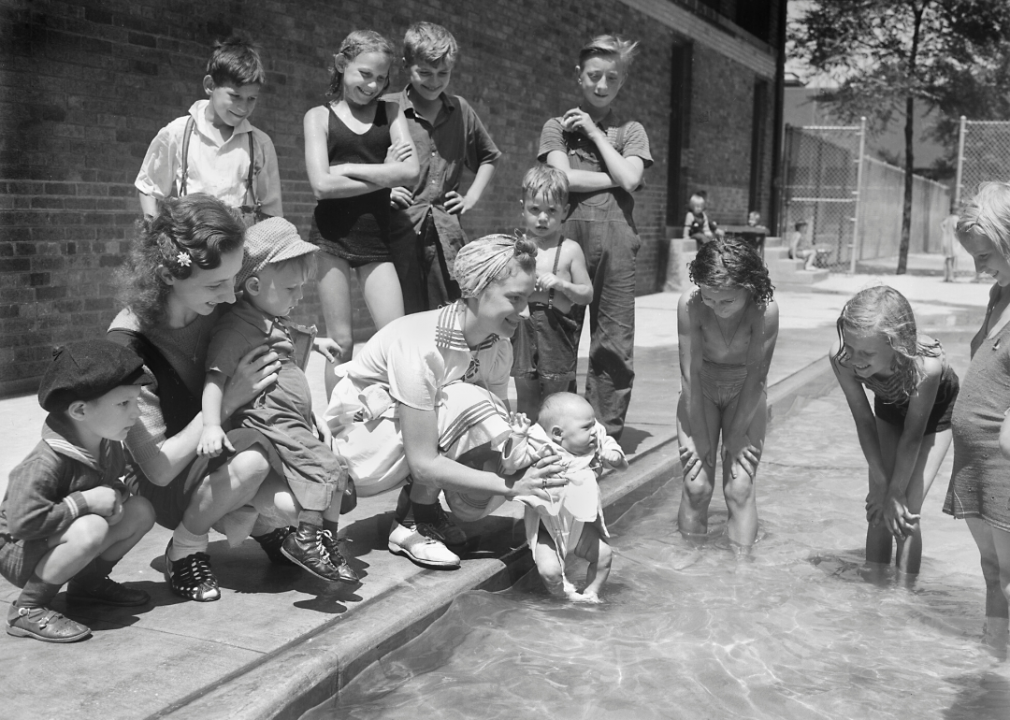
Hulton Archive // Getty Images
1941: A wild mix of dry and wet
– Average summer temperature: 71.3 F (#68 warmest year; 0.2% below 100-year average)
– Maximum summer temperature: 83.8 F (#79 warmest year; 0.7% below 100-year average)
– Minimum summer temperature: 58.7 F (#51 warmest year; 0.5% above 100-year average)
– Precipitation: 9.7 inches (#3 highest; 16.9% above 100-year average)
The summer of 1941 was very polarized even within the United States. In the Southwest, there were colder than usual temperatures and much heavier precipitation. In the Midwest and parts of the South, people experienced warmer temperatures and extreme drought conditions.
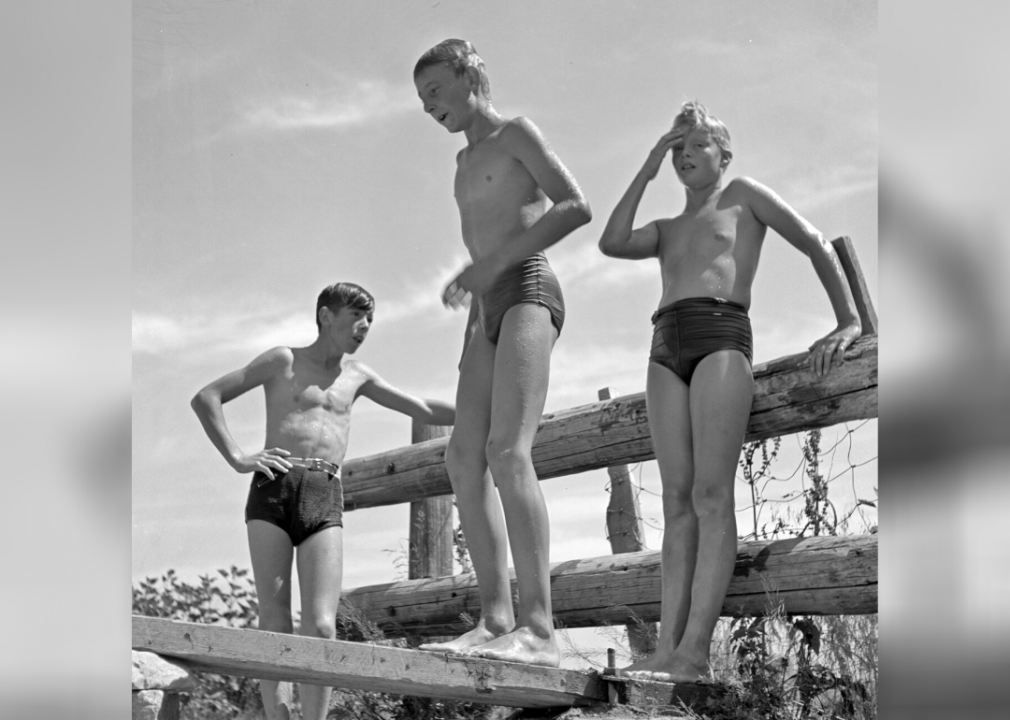
Universal History Archive // Getty Images
1942: A cooler, wetter summer
– Average summer temperature: 71.2 F (#72 warmest year; 0.3% below 100-year average)
– Maximum summer temperature: 84.1 F (#76 warmest year; 0.4% below 100-year average)
– Minimum summer temperature: 58.4 F (#67 warmest year; 0.1% below 100-year average)
– Precipitation: 9.1 inches (#15 highest; 9.9% above 100-year average)
The summer of 1942 was the cold centerpiece of a colder than average year. There was heavier than usual precipitation across the entire breadth of the country in the Midwest, with pockets of extreme drought in the eastern United States
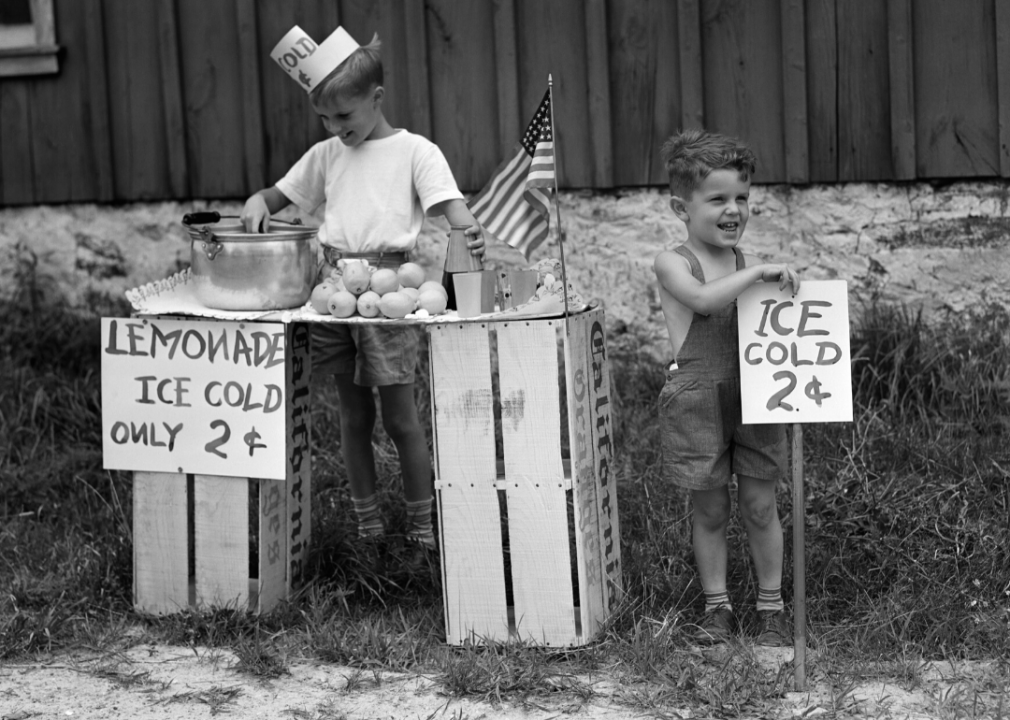
H. Armstrong Roberts/ClassicStock // Getty Images
1943: A warmer, drier summer
– Average summer temperature: 72.2 F (#31 warmest year; 1.1% above 100-year average)
– Maximum summer temperature: 85.3 F (#28 warmest year; 1% above 100-year average)
– Minimum summer temperature: 59.1 F (#39 warmest year; 1.1% above 100-year average)
– Precipitation: 8 inches (#76 highest; 4.3% below 100-year average)
In 1943, temperatures were higher than usual during the year, but in a very marbled mixture around the United States and in the rest of the world. In the South, conditions were on the drier side, and in the Midwest and Pacific Northwest, there was more precipitation than usual.
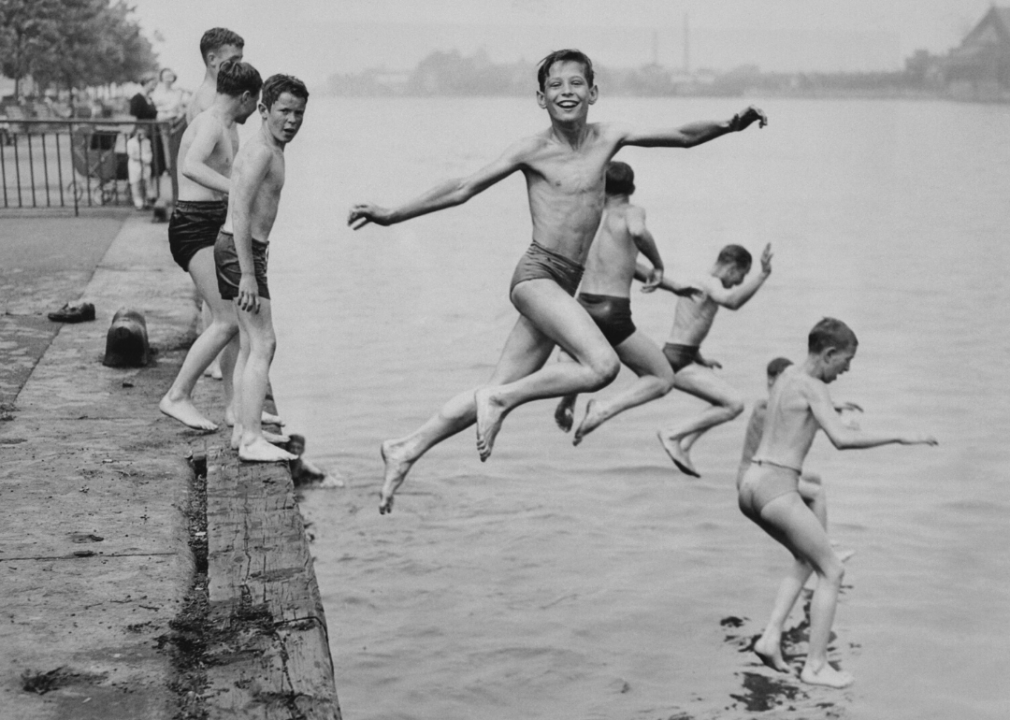
Bettman // Getty Images
1944: A cooler, average summer
– Average summer temperature: 71.1 F (#77 warmest year; 0.4% below 100-year average)
– Maximum summer temperature: 84.4 F (#67 warmest year; 0% below 100-year average)
– Minimum summer temperature: 57.8 F (#86 warmest year; 1% below 100-year average)
– Precipitation: 8.3 inches (#59 highest; 0.5% below 100-year average)
Temperatures in the summer of 1944 balanced out to an overall “average” value, but the Midwest was colder and wetter, while Indiana and Ohio experienced higher temperatures and drought. The same mixed bag repeated around the world.
You may also like: Most expensive weather disasters from every state

Science & Society Picture Library // Getty Images
1945: A cooler, wetter summer
– Average summer temperature: 70.3 F (#95 warmest year; 1.5% below 100-year average)
– Maximum summer temperature: 83.2 F (#90 warmest year; 1.4% below 100-year average)
– Minimum summer temperature: 57.4 F (#94 warmest year; 1.7% below 100-year average)
– Precipitation: 9.1 inches (#17 highest; 8.9% above 100-year average)
The overall weather in 1945 was much colder than usual. That translated to a colder, much wetter summer around almost the entire continental United States.

Kirn Vintage Stock/Corbis via Getty Images
1946: A cooler, drier summer
– Average summer temperature: 71.1 F (#75 warmest year; 0.4% below 100-year average)
– Maximum summer temperature: 84.3 F (#69 warmest year; 0.1% below 100-year average)
– Minimum summer temperature: 57.9 F (#84 warmest year; 0.9% below 100-year average)
– Precipitation: 8 inches (#74 highest; 3.5% below 100-year average)
After the cold, wet summer of 1945, the weather in 1946 reverted to the mean. In the summer, that translated to pockets of high and low precipitation around the United States as well as temperatures that ping-ponged around the average mark.
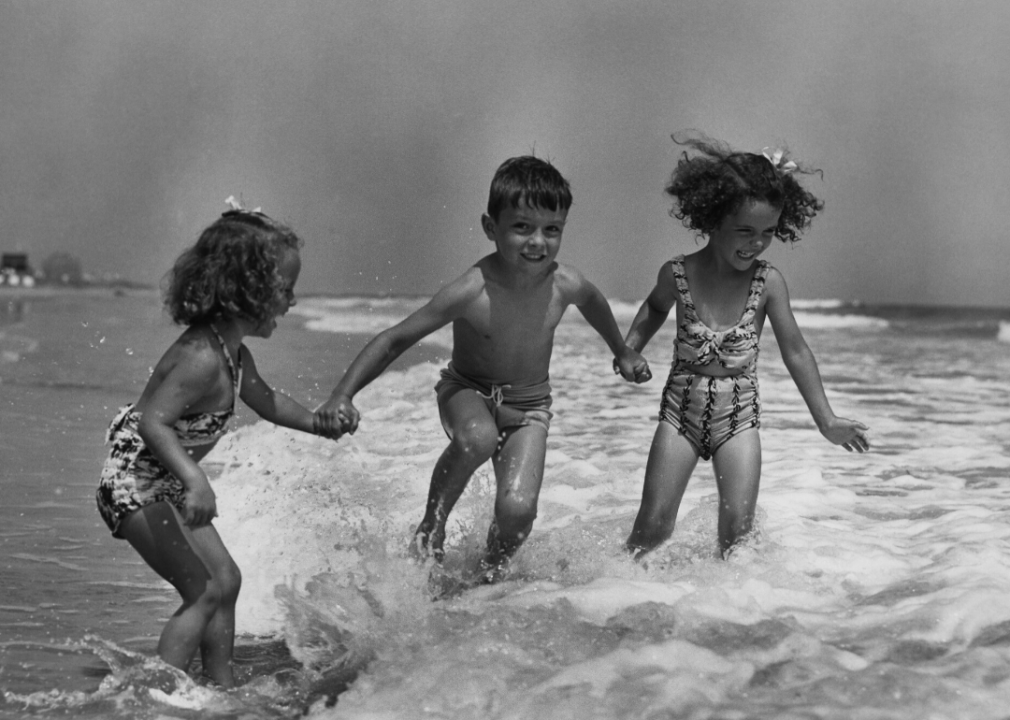
Lambert // Getty Images
1947: A rainy summer in the Midwest
– Average summer temperature: 71.2 F (#73 warmest year; 0.3% below 100-year average)
– Maximum summer temperature: 84.2 F (#72 warmest year; 0.2% below 100-year average)
– Minimum summer temperature: 58.2 F (#75 warmest year; 0.4% below 100-year average)
– Precipitation: 8.2 inches (#63 highest; 1.3% below 100-year average)
In 1947, the United States was colder than usual and the hottest anomalous temperatures throughout the summer were in Europe. The Midwest experienced much heavier precipitation than average, as did upstate New York.

Rae Russell // Getty Images
1948: Wet and dry
– Average summer temperature: 71.4 F (#64 warmest year; 0.1% below 100-year average)
– Maximum summer temperature: 84.5 F (#60 warmest year; 0.1% above 100-year average)
– Minimum summer temperature: 58.3 F (#73 warmest year; 0.3% below 100-year average)
– Precipitation: 8.5 inches (#45 highest; 2.5% above 100-year average)
The temperatures overall were very average in 1948, just a shade colder than usual. That translated to warmer temperatures along the southern United States that summer and colder temperatures along the Pacific coast, with extreme precipitation there and some drought conditions in the Midwest.
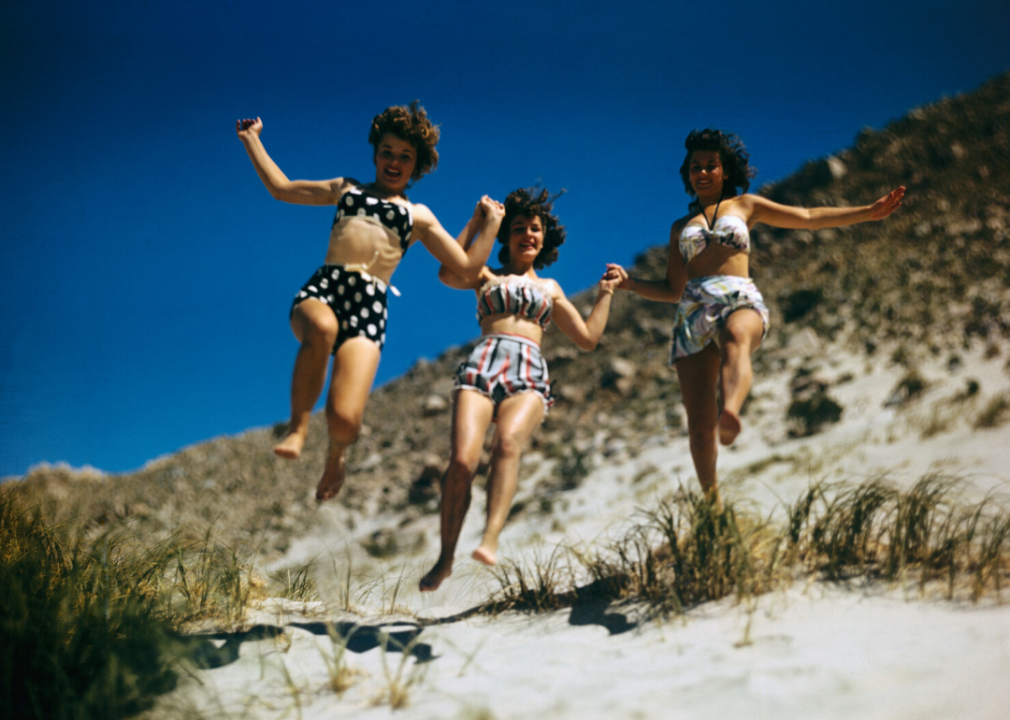
Bettman // Getty Images
1949: An average summer, on the wet side
– Average summer temperature: 71.9 F (#48 warmest year; 0.6% above 100-year average)
– Maximum summer temperature: 84.9 F (#44 warmest year; 0.6% above 100-year average)
– Minimum summer temperature: 58.8 F (#50 warmest year; 0.7% above 100-year average)
– Precipitation: 8.8 inches (#30 highest; 5.4% above 100-year average)
The temperature was almost exactly on average during 1949, including the summer. Within the continental United States, that meant a little cold with a lot of precipitation along the entire southern United States and some warmer and even drought conditions along the entire northern United States.
You may also like: 30 of the most devastating hailstorms in U.S. history
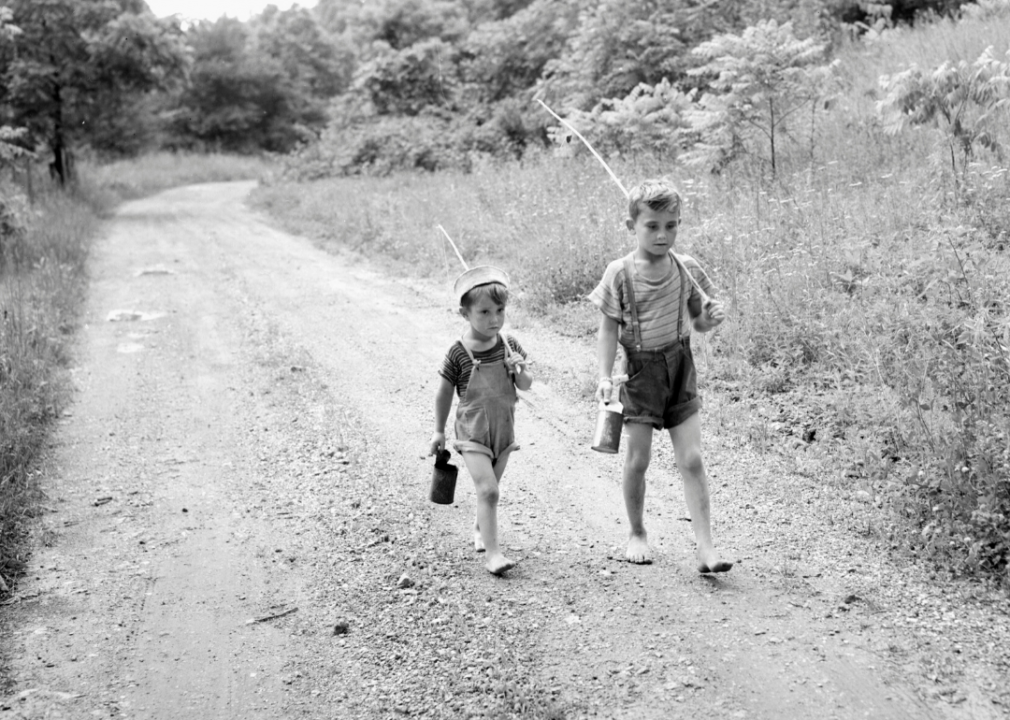
Kirn Vintage Stock/Corbis via Getty Images
1950: A cool and wet summer
– Average summer temperature: 69.7 F (#99 warmest year; 2.3% below 100-year average)
– Maximum summer temperature: 82.8 F (#95 warmest year; 1.9% below 100-year average)
– Minimum summer temperature: 56.7 F (#100 warmest year; 3% below 100-year average)
– Precipitation: 9.2 inches (#13 highest; 10.7% above 100-year average)
In 1950, the overall temperature was much colder than average for the year. But in the summer, there were pockets of heavy rainfall and cold temperatures and other places with drought conditions and a warmer summer.

Found Images Holding Inc. // Getty Images
1951: Heavy rain in the Midwest
– Average summer temperature: 70.7 F (#84 warmest year; 0.9% below 100-year average)
– Maximum summer temperature: 83.7 F (#81 warmest year; 0.8% below 100-year average)
– Minimum summer temperature: 57.8 F (#87 warmest year; 1.1% below 100-year average)
– Precipitation: 8.9 inches (#23 highest; 7% above 100-year average)
During the overall cold temperatures of 1951, the summer was a mix of hotter and colder than usual. Indeed, there was heavy rainfall in Kansas and Nebraska at the same time as extreme drought in parts of neighboring Colorado, Arizona, and New Mexico.
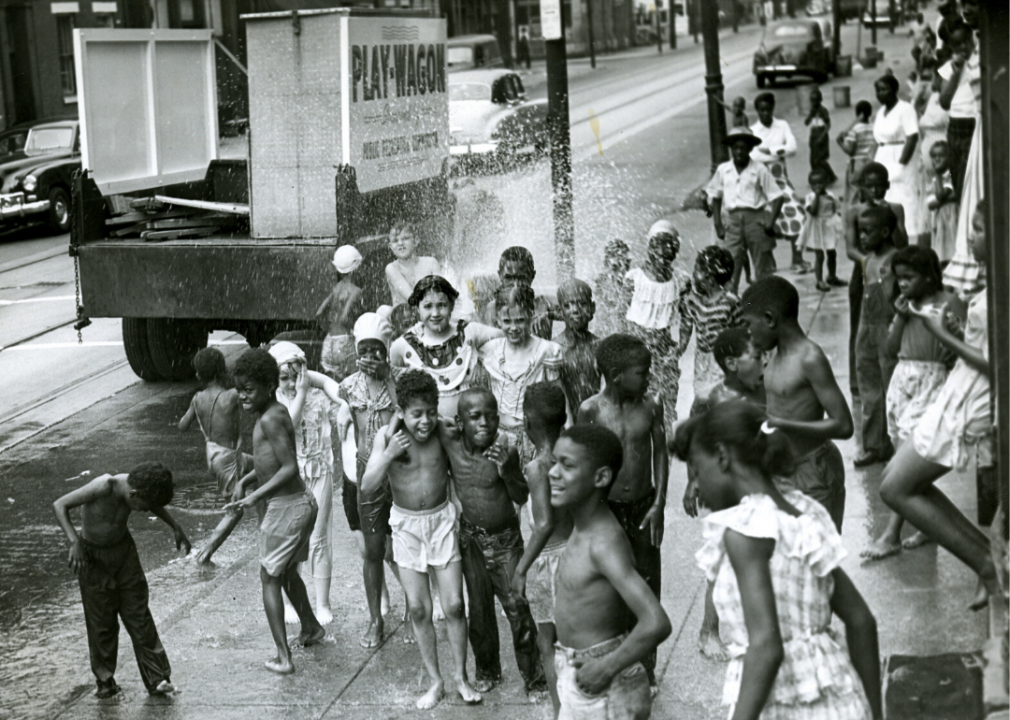
Cincinnati Museum Center // Getty Images
1952: Drought in Texas
– Average summer temperature: 72.6 F (#20 warmest year; 1.6% above 100-year average)
– Maximum summer temperature: 86 F (#12 warmest year; 1.9% above 100-year average)
– Minimum summer temperature: 59.1 F (#37 warmest year; 1.2% above 100-year average)
– Precipitation: 7.2 inches (#91 highest; 13.3% below 100-year average)
The entire country had hotter-than-usual temperatures during the summer of 1952. On top of that, Texas in particular had extreme drought that lasted for much of the year.
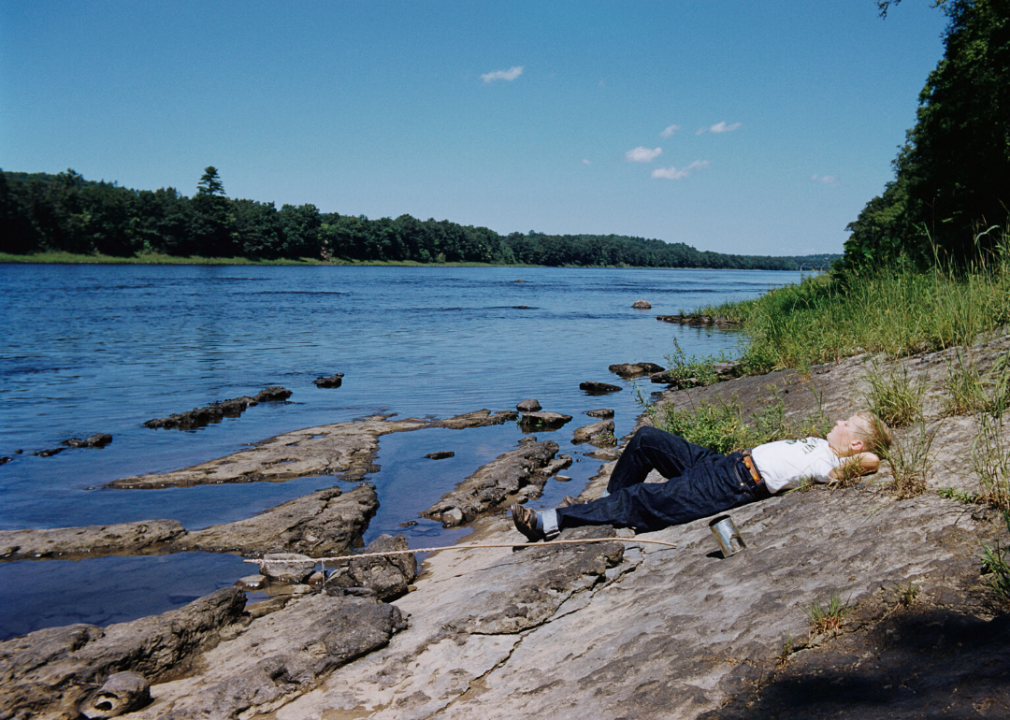
Steven Gottlieb/Corbis Historical // Getty Images
1953: El Nino begins
– Average summer temperature: 72.2 F (#32 warmest year; 1% above 100-year average)
– Maximum summer temperature: 85.5 F (#21 warmest year; 1.3% above 100-year average)
– Minimum summer temperature: 58.8 F (#47 warmest year; 0.7% above 100-year average)
– Precipitation: 7.5 inches (#86 highest; 10.1% below 100-year average)
In 1953, an El Nino phenomenon circled the world, lasting into 1954. Warmer than usual ocean currents spread warm temperatures and milder conditions around the world.

Debrocke Classic Stock // Getty Images
1954: An emerging La Nina
– Average summer temperature: 72.2 F (#30 warmest year; 1.1% above 100-year average)
– Maximum summer temperature: 85.5 F (#20 warmest year; 1.3% above 100-year average)
– Minimum summer temperature: 58.8 F (#46 warmest year; 0.7% above 100-year average)
– Precipitation: 7 inches (#94 highest; 15.5% below 100-year average)
A cold-water La Nina began in 1954 that didn’t end until 1956, creating unusual circumstances for precipitation and other consequences around the world. But the summer of 1954 was still warmer than usual, proportionally more so than the following two summers.
You may also like: Fastest-warming cities in the U.S.
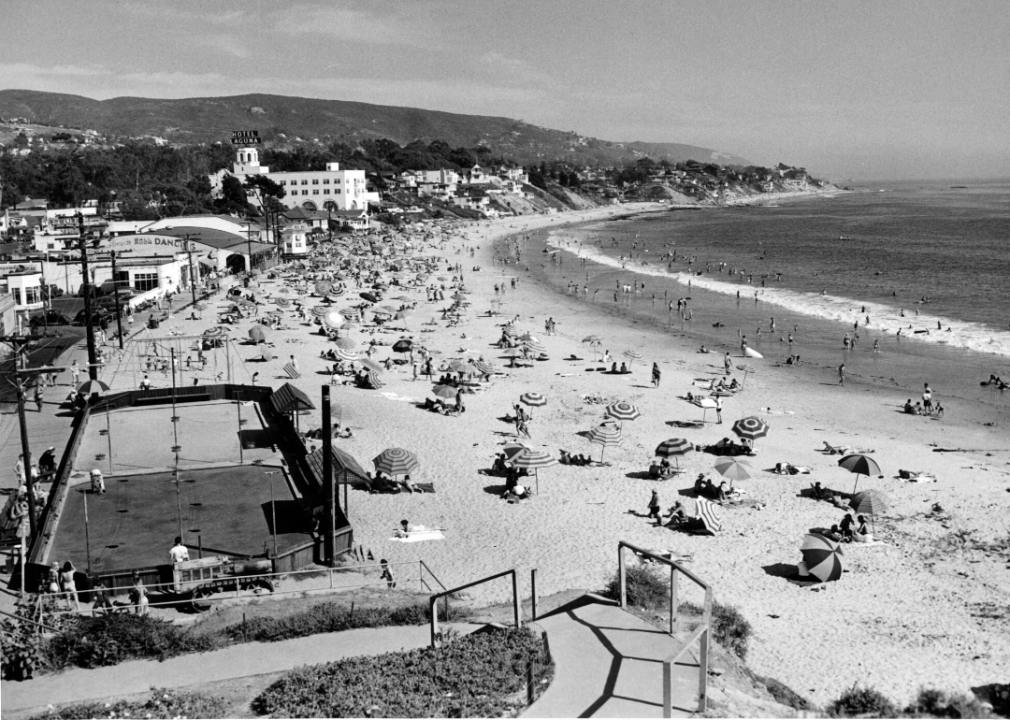
American Stock Archive // Getty Images
1955: Hurricane Janet slams the Caribbean
– Average summer temperature: 71.6 F (#58 warmest year; 0.3% above 100-year average)
– Maximum summer temperature: 84.6 F (#51 warmest year; 0.3% above 100-year average)
– Minimum summer temperature: 58.6 F (#59 warmest year; 0.3% above 100-year average)
– Precipitation: 8.1 inches (#69 highest; 2.3% below 100-year average)
Hurricane Janet struck the upper Caribbean in September of 1955. The Category 5 hurricane also made landfall on mainland Mexico.

ullstein bild Dtl. // Getty Images
1956: Drought and heat in the Midwest
– Average summer temperature: 71.7 F (#56 warmest year; 0.4% above 100-year average)
– Maximum summer temperature: 85.2 F (#34 warmest year; 0.9% above 100-year average)
– Minimum summer temperature: 58.3 F (#73 warmest year; 0.3% below 100-year average)
– Precipitation: 7.2 inches (#92 highest; 13.5% below 100-year average)
The average temperature in 1956 was overall pretty normal, but the central United States, including parts of the Midwest, experienced higher than usual summer temperatures and extreme drought conditions. That drought extended southward into Texas and the Southwest.
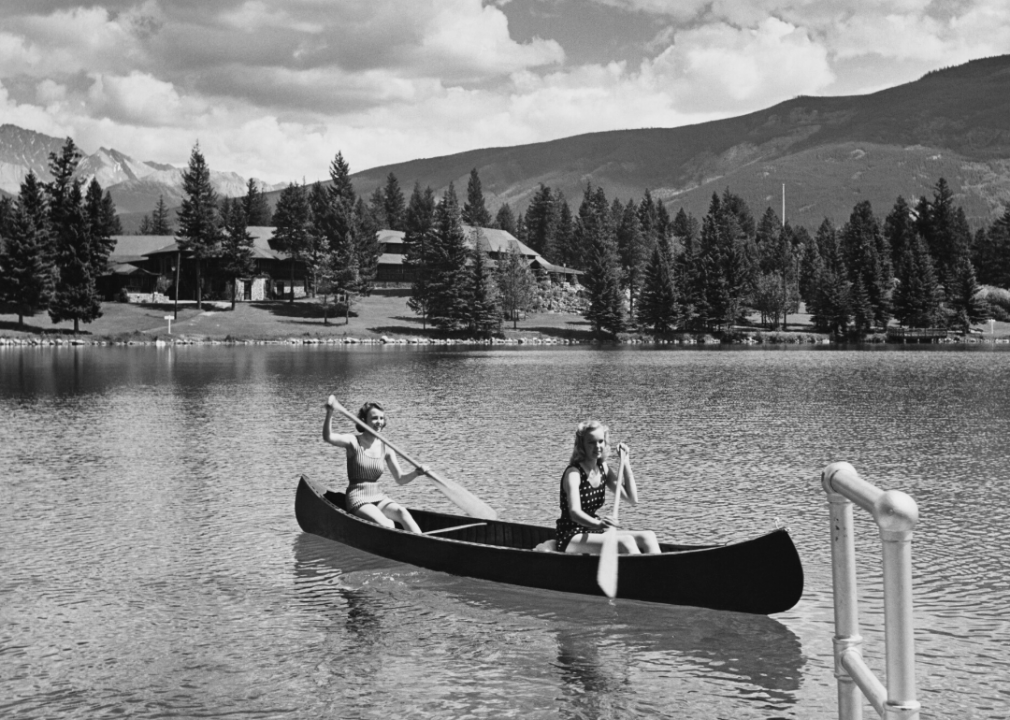
Everett Collection // Shutterstock
1957: A warm El Nino
– Average summer temperature: 71.5 F (#60 warmest year; 0.2% above 100-year average)
– Maximum summer temperature: 84.5 F (#61 warmest year; 0.1% above 100-year average)
– Minimum summer temperature: 58.7 F (#56 warmest year; 0.4% above 100-year average)
– Precipitation: 8.1 inches (#70 highest; 2.4% below 100-year average)
An El Nino phenomenon warmed the oceans during the summer of 1957 and through to part of 1958. It caused widespread effects far from the original current and affected the entire world.

RGallianos // Shutterstock
1958: Continuing El Nino effects
– Average summer temperature: 71.3 F (#68 warmest year; 0.2% below 100-year average)
– Maximum summer temperature: 84.1 F (#74 warmest year; 0.4% below 100-year average)
– Minimum summer temperature: 58.5 F (#63 warmest year; 0.1% above 100-year average)
– Precipitation: 9.5 inches (#6 highest; 13.7% above 100-year average)
The summer of 1958 began with the tail of one El Nino and ended with signs of a brief resurgence of the same. By the end of 1958, the effect picked up and lasted into spring of 1959.
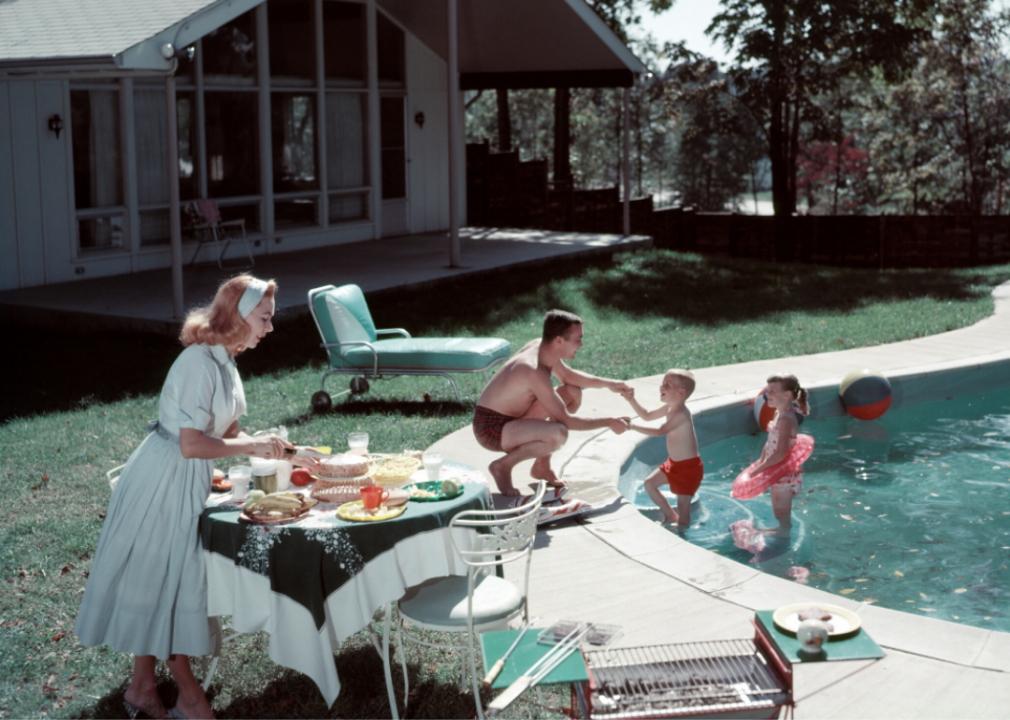
H. Armstrong Roberts/ClassicStock // Getty Images
1959: Warm and sometimes dry
– Average summer temperature: 72.2 F (#28 warmest year; 1.2% above 100-year average)
– Maximum summer temperature: 85.4 F (#23 warmest year; 1.1% above 100-year average)
– Minimum summer temperature: 59.1 F (#36 warmest year; 1.2% above 100-year average)
– Precipitation: 8.3 inches (#54 highest; 0% below 100-year average)
The summer of 1959 was warmer than usual across most of the United States and colder than usual across all of Canada. There were drought conditions in the Southwest and precipitation to the point of flooding in southern Florida.
You may also like: U.S. cities with the cleanest air
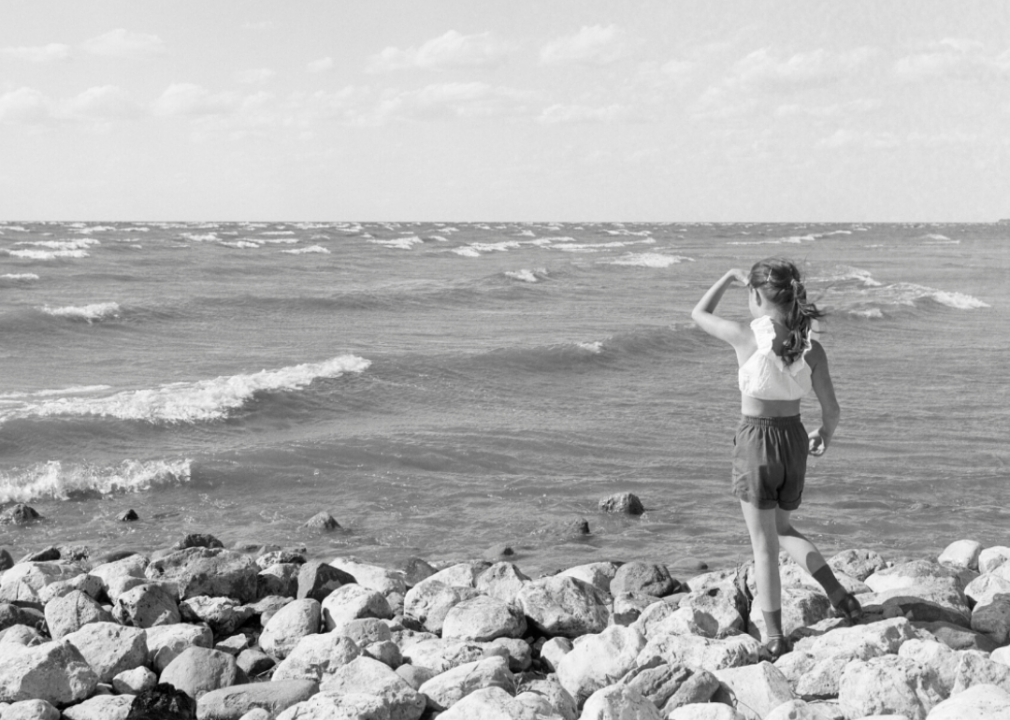
Classic Stock // Getty Images
1960: Drought in Wyoming
– Average summer temperature: 71.7 F (#54 warmest year; 0.5% above 100-year average)
– Maximum summer temperature: 85.1 F (#38 warmest year; 0.8% above 100-year average)
– Minimum summer temperature: 58.4 F (#67 warmest year; 0.1% below 100-year average)
– Precipitation: 8.2 inches (#64 highest; 1.4% below 100-year average)
In the summer of 1960, there were severe drought conditions across parts of Nevada, Wyoming, and Montana. That summer, the most anomalously warm temperatures were at the northernmost reaches of Canada, Europe, and Russia.
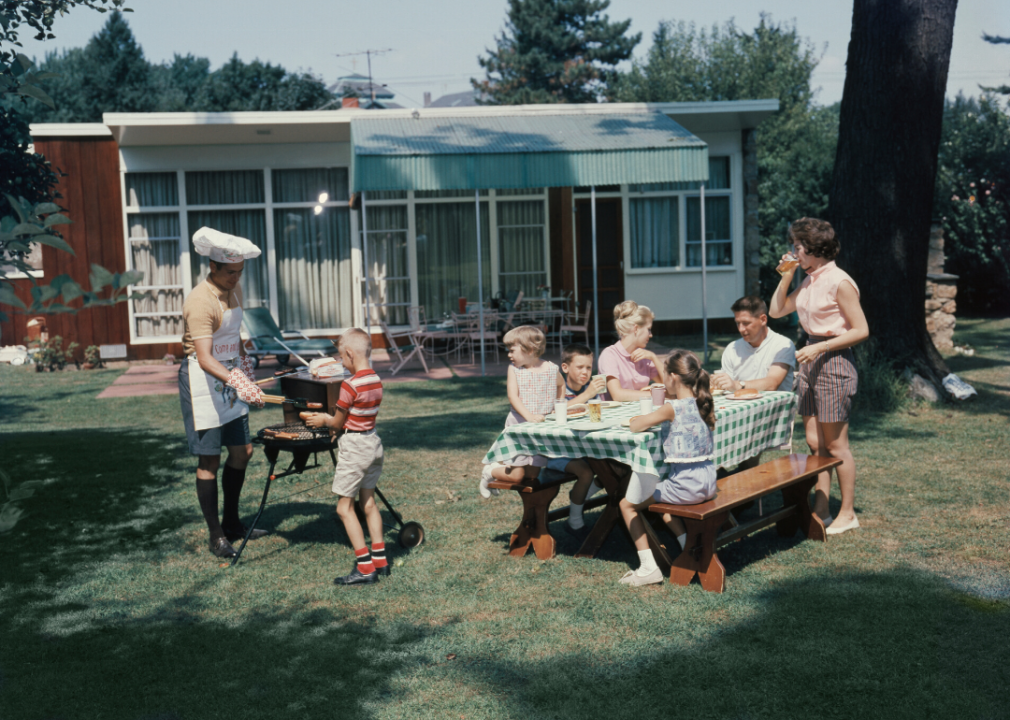
Lambert // Getty Images
1961: Hurricane Esther and Hattie
– Average summer temperature: 71.8 F (#50 warmest year; 0.6% above 100-year average)
– Maximum summer temperature: 85 F (#42 warmest year; 0.7% above 100-year average)
– Minimum summer temperature: 58.7 F (#56 warmest year; 0.4% above 100-year average)
– Precipitation: 8.7 inches (#37 highest; 4% above 100-year average)
Hurricane Esther swirled off the coast of New England as a Category 5 hurricane before weakening as it approached land. Fortunately, the damage was mild compared to the initial force of the storm. Hurricane Hattie struck the same year, affecting the British Honduras.

H. Armstrong Roberts/ClassicStock // Getty Images
1962: Heavy rain in the Midwest
– Average summer temperature: 70.7 F (#85 warmest year; 1% below 100-year average)
– Maximum summer temperature: 83.9 F (#78 warmest year; 0.6% below 100-year average)
– Minimum summer temperature: 57.5 F (#93 warmest year; 1.5% below 100-year average)
– Precipitation: 8.2 inches (#67 highest; 1.9% below 100-year average)
This was a wet summer for the northern Midwest, where lower than usual temperatures accompanied the heavy rainfall. In the South, including both Texas and Florida, there were some drought conditions.
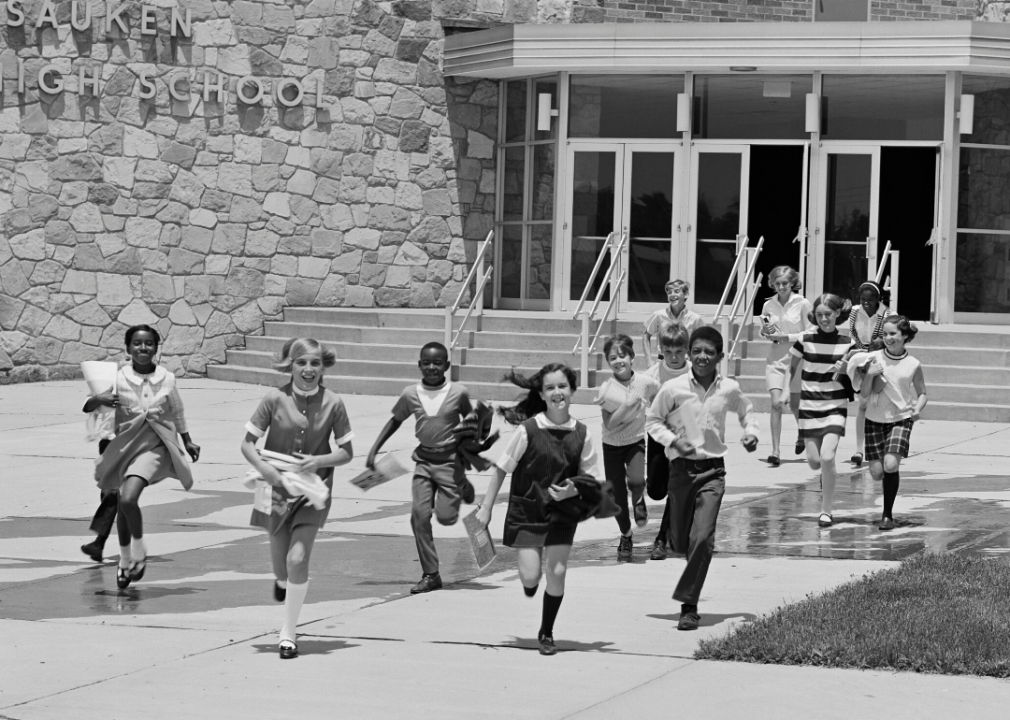
H. Armstrong Roberts/ClassicStock // Getty Images
1963: Ocean current affairs
– Average summer temperature: 71.4 F (#62 warmest year; 0% above 100-year average)
– Maximum summer temperature: 84.4 F (#64 warmest year; 0% below 100-year average)
– Minimum summer temperature: 58.5 F (#64 warmest year; 0.1% above 100-year average)
– Precipitation: 8 inches (#76 highest; 4.3% below 100-year average)
In the summer of 1963, the world experienced consequences of a brief El Nino before whiplashing with a La Nina in 1964 and another El Nino in 1965. The central United States was warmer than usual while both coasts were colder.
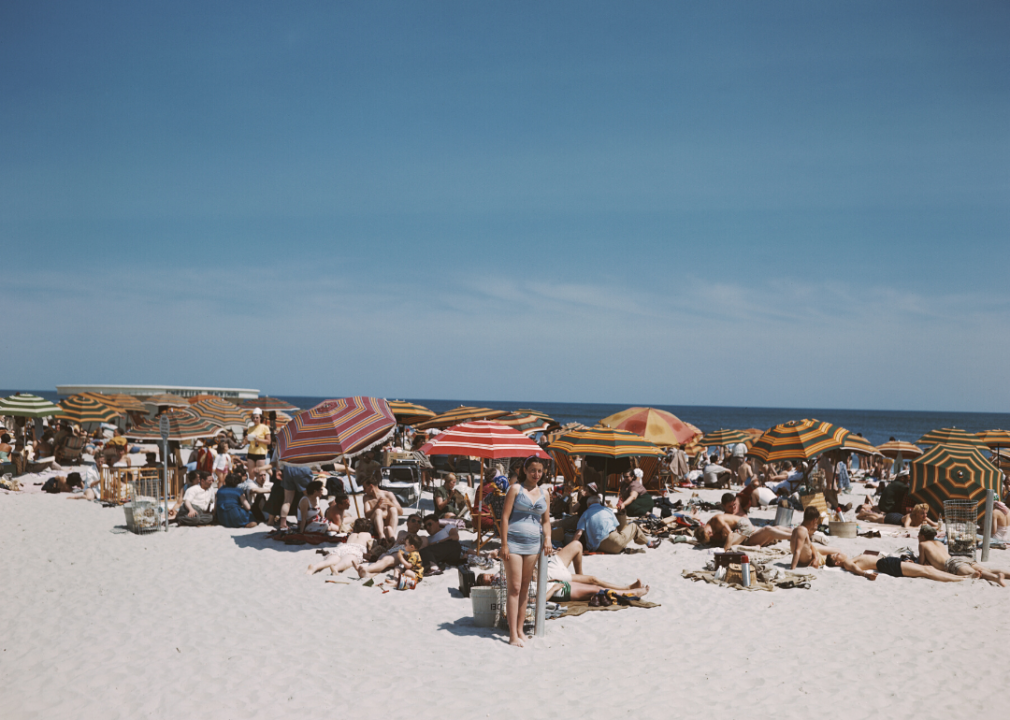
Pictorial Parade // Getty Images
1964: Cooler around the world
– Average summer temperature: 71.1 F (#74 warmest year; 0.4% below 100-year average)
– Maximum summer temperature: 84.1 F (#75 warmest year; 0.4% below 100-year average)
– Minimum summer temperature: 58.2 F (#77 warmest year; 0.4% below 100-year average)
– Precipitation: 8.3 inches (#56 highest; 0.4% below 100-year average)
The whole world was anomalously cold during the summer of 1964, with an exception in the center of the United States. There, temperatures were slightly warmer and induced some drought conditions in the Midwest.
You may also like: U.S. cities with the dirtiest air
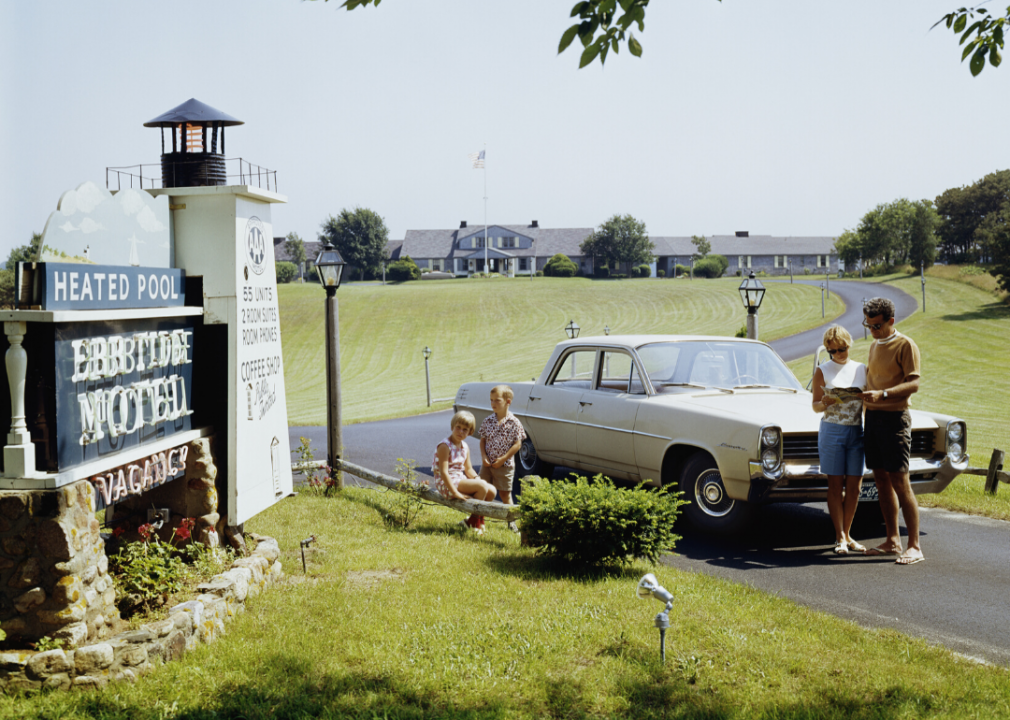
Aladdin Color Inc/Corbis Historical // Getty Images
1965: Staying cool goes global
– Average summer temperature: 70.2 F (#97 warmest year; 1.7% below 100-year average)
– Maximum summer temperature: 82.8 F (#96 warmest year; 1.9% below 100-year average)
– Minimum summer temperature: 57.6 F (#92 warmest year; 1.4% below 100-year average)
– Precipitation: 8.8 inches (#30 highest; 5.4% above 100-year average)
In one of the coldest summers in this 100-year range, much of the world was also experiencing unseasonably cold temperatures. The northeastern United States experienced extreme drought conditions while most of the western half of the nation was drenched.

Lambert // Getty Images
1966: A dry, cool summer
– Average summer temperature: 71.3 F (#66 warmest year; 0.2% below 100-year average)
– Maximum summer temperature: 84.4 F (#63 warmest year; 0% below 100-year average)
– Minimum summer temperature: 58.2 F (#76 warmest year; 0.4% below 100-year average)
– Precipitation: 7.8 inches (#79 highest; 6.7% below 100-year average)
During a low-average summer, the United States was joined by mostly mild temperatures around the rest of the world. Still, there were drought conditions in large pockets of the United States.
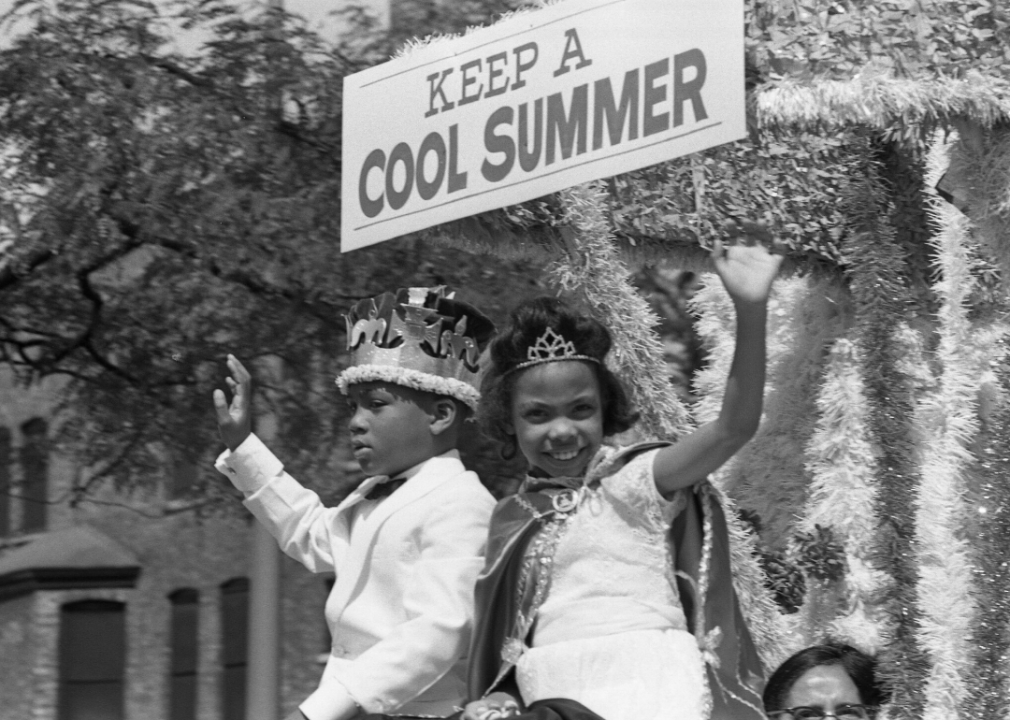
Robert Abbott Sengstacke // Getty Images
1967: A cool summer with mixed rain
– Average summer temperature: 70.4 F (#91 warmest year; 1.3% below 100-year average)
– Maximum summer temperature: 83.1 F (#91 warmest year; 1.5% below 100-year average)
– Minimum summer temperature: 57.7 F (#90 warmest year; 1.2% below 100-year average)
– Precipitation: 9 inches (#20 highest; 7.9% above 100-year average)
The summer of 1967 was colder than usual in the United States as well as much of the rest of the world, with hotter temperatures in Canada and along northern Russia. A drought in Texas early in the season transitioned to a wetter season in the Rocky Mountain states.

H. Armstrong Roberts/ClassicStock // Getty Images
1968: Dry and cool in the US
– Average summer temperature: 70.7 F (#87 warmest year; 1% below 100-year average)
– Maximum summer temperature: 83.3 F (#89 warmest year; 1.3% below 100-year average)
– Minimum summer temperature: 58 F (#79 warmest year; 0.7% below 100-year average)
– Precipitation: 8.8 inches (#30 highest; 5.4% above 100-year average)
The United States and much of the rest of the world experienced a colder than usual summer in 1968. In fact, Alaska had some of the only anomalously warm data in the entire United States.
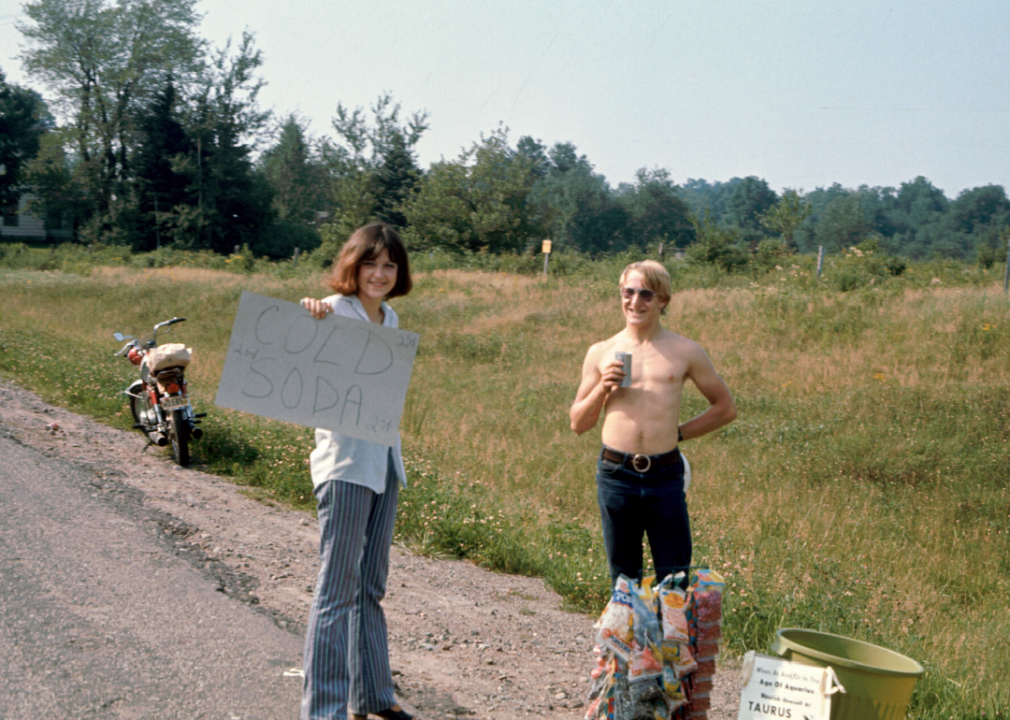
Ralph Ackerman // Getty Images
1969: Hurricane Camille damages the Gulf
– Average summer temperature: 71.4 F (#63 warmest year; 0% below 100-year average)
– Maximum summer temperature: 84.3 F (#70 warmest year; 0.2% below 100-year average)
– Minimum summer temperature: 58.5 F (#62 warmest year; 0.2% above 100-year average)
– Precipitation: 8.7 inches (#34 highest; 4.7% above 100-year average)
Hurricane Camille pummeled the Gulf coast in August of 1969, focused on coastal Mississippi. The storm weakened as it passed overland and returned to nearly full strength again in the Atlantic Ocean.
You may also like: How climate change has affected each state

H. Armstrong Roberts/ClassicStock // Getty Images
1970: A warm and dry summer
– Average summer temperature: 72 F (#37 warmest year; 0.9% above 100-year average)
– Maximum summer temperature: 85.2 F (#29 warmest year; 1% above 100-year average)
– Minimum summer temperature: 58.8 F (#45 warmest year; 0.7% above 100-year average)
– Precipitation: 7.6 inches (#84 highest; 9.3% below 100-year average)
The summer of 1970 was a little above average temperature. Everywhere in the United States had basically normal weather except for a few cold pockets, including one in southern California.

H. Armstrong Roberts/ClassicStock // Getty Images
1971: Heavy rain in the Rockies
– Average summer temperature: 71.3 F (#69 warmest year; 0.2% below 100-year average)
– Maximum summer temperature: 84.3 F (#69 warmest year; 0.1% below 100-year average)
– Minimum summer temperature: 58.2 F (#74 warmest year; 0.3% below 100-year average)
– Precipitation: 8.3 inches (#59 highest; 0.5% below 100-year average)
The summer of 1971 saw below average temperatures around almost the whole world. In the United States, that included very wet weather in the Rocky Mountains and drought conditions extending down into Texas.
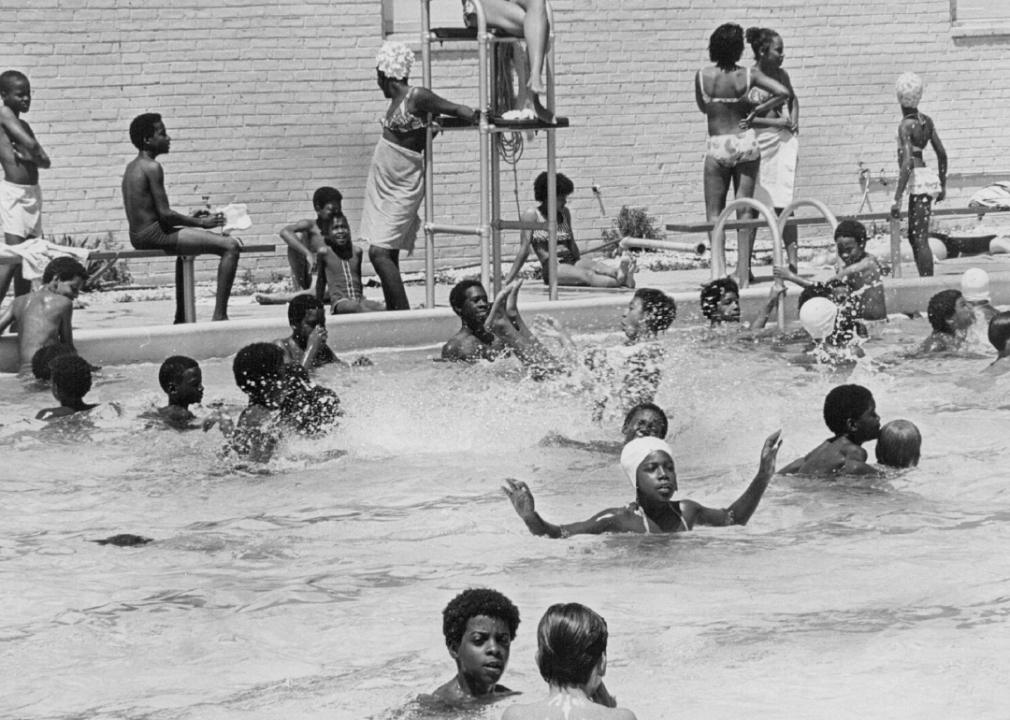
Ira Gay Sealy/Denver Post // Getty Images
1972: Rainy days in the north
– Average summer temperature: 70.7 F (#86 warmest year; 1% below 100-year average)
– Maximum summer temperature: 83.5 F (#86 warmest year; 1.1% below 100-year average)
– Minimum summer temperature: 57.9 F (#85 warmest year; 0.9% below 100-year average)
– Precipitation: 8.7 inches (#36 highest; 4.2% above 100-year average)
In the overall cool summer of 1972, the United States experienced lower than average temperatures that matched much of the world except unseasonably warm parts of Europe. Much of the northern United States experienced heavier rainfall than usual, and the Southwest experienced some drought conditions.

Classic Stock // Getty Images
1973: Welcoming a long La Nina
– Average summer temperature: 71.6 F (#59 warmest year; 0.3% above 100-year average)
– Maximum summer temperature: 84.6 F (#57 warmest year; 0.2% above 100-year average)
– Minimum summer temperature: 58.6 F (#58 warmest year; 0.4% above 100-year average)
– Precipitation: 8.1 inches (#73 highest; 3% below 100-year average)
A cold-water La Nina event began in early 1973 and lasted a full three years. In the low-average temperatures of the summer of 1973, the United States experienced heavy rainfall almost everywhere but the Pacific Northwest, where there were drought conditions.
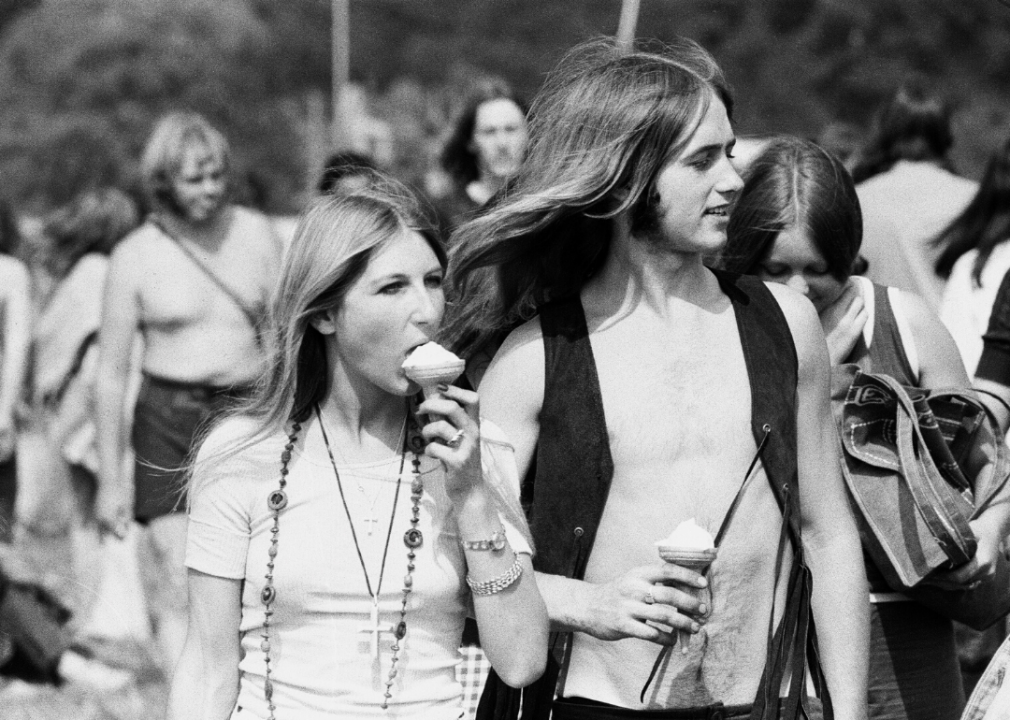
Mirrorpix // Getty Images
1974: Hurricane Fifi/Orlene
– Average summer temperature: 71 F (#81 warmest year; 0.6% below 100-year average)
– Maximum summer temperature: 84.2 F (#71 warmest year; 0.2% below 100-year average)
– Minimum summer temperature: 57.7 F (#91 warmest year; 1.2% below 100-year average)
– Precipitation: 8.2 inches (#63 highest; 1.3% below 100-year average)
Hurricane Fifi, which later was named Hurricane Orlene, struck the Caribbean and Central America in 1974. The relatively low-power Category 2 storm caused more than 8,000 deaths due to flooding and other secondary effects.
You may also like: Fastest-warming states in the U.S.

Classic Stock // Getty Images
1975: Heavy rain in Montana
– Average summer temperature: 70.9 F (#82 warmest year; 0.7% below 100-year average)
– Maximum summer temperature: 83.4 F (#87 warmest year; 1.1% below 100-year average)
– Minimum summer temperature: 58.3 F (#70 warmest year; 0.2% below 100-year average)
– Precipitation: 9.1 inches (#16 highest; 9.5% above 100-year average)
A stripe of high temperatures traced across Canada and into Europe during the summer of 1975, but the rest of the world was colder than usual. Into that mix, the southern United States experienced heavy rainfall, as did, of all places, Montana.

Classic Stock // Getty Images
1976: Extreme drought in the Midwest
– Average summer temperature: 70.5 F (#90 warmest year; 1.3% below 100-year average)
– Maximum summer temperature: 83.6 F (#82 warmest year; 0.9% below 100-year average)
– Minimum summer temperature: 57.3 F (#96 warmest year; 1.9% below 100-year average)
– Precipitation: 7.5 inches (#85 highest; 9.7% below 100-year average)
Much of the world experienced colder than usual temperatures in the summer of 1976, with a large warm exception for westernmost Europe and the United Kingdom. In the United States, a drought began and spread in the upper Midwest, reaching extreme conditions by the end of the summer.
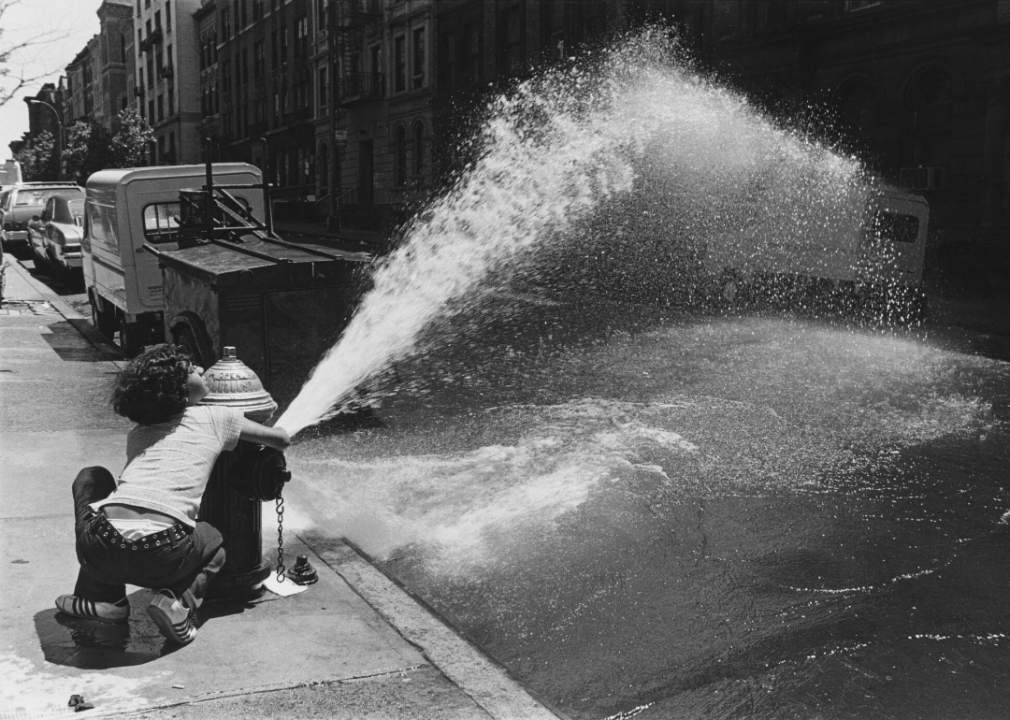
Barbara Alper // Getty Images
1977: A worsening drought
– Average summer temperature: 72.2 F (#29 warmest year; 1.1% above 100-year average)
– Maximum summer temperature: 85 F (#40 warmest year; 0.7% above 100-year average)
– Minimum summer temperature: 59.3 F (#24 warmest year; 1.6% above 100-year average)
– Precipitation: 8.6 inches (#40 highest; 3.4% above 100-year average)
The drought that began in 1976 grew and intensified in the summer of 1977. Canada was unseasonably cool, but the United States and a band that extended all the way through western Canada into Alaska were unseasonably warm and mostly vulnerable to drought.
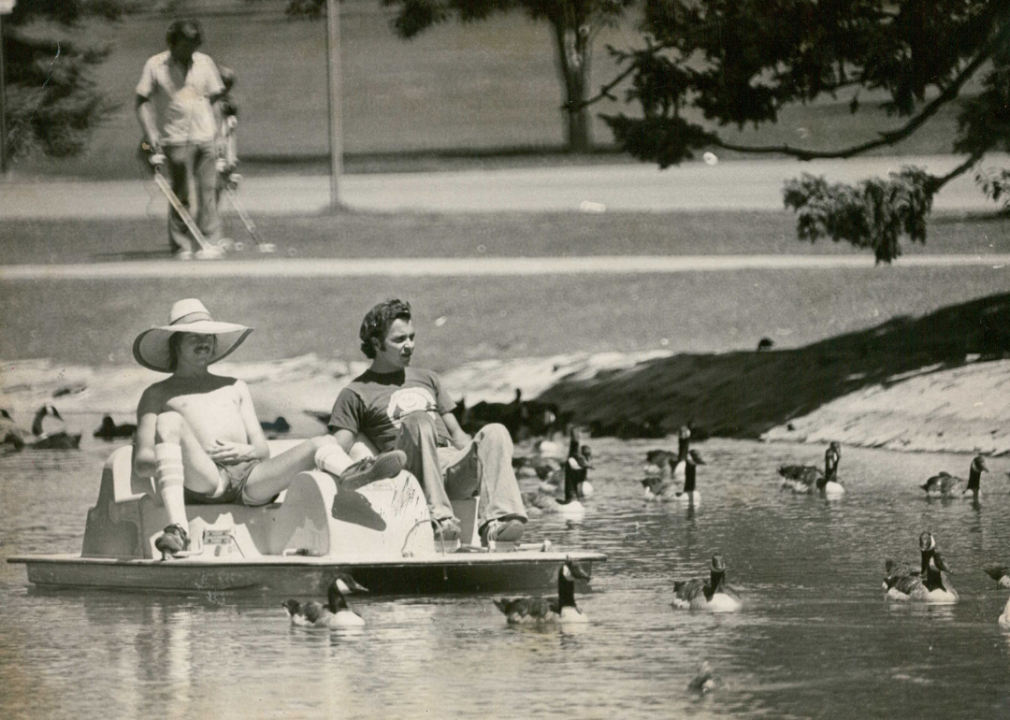
Duane Howell/Denver Post // Getty Images
1978: A mild and average summer
– Average summer temperature: 71.5 F (#61 warmest year; 0.2% above 100-year average)
– Maximum summer temperature: 84.6 F (#53 warmest year; 0.3% above 100-year average)
– Minimum summer temperature: 58.4 F (#65 warmest year; 0% below 100-year average)
– Precipitation: 8.1 inches (#73 highest; 3% below 100-year average)
After the previous severe summers, 1978 was mild and mellow. The temperature was low-average despite a colder trend in much of the rest of the world, and just small pockets experienced heavy precipitation or drought conditions.
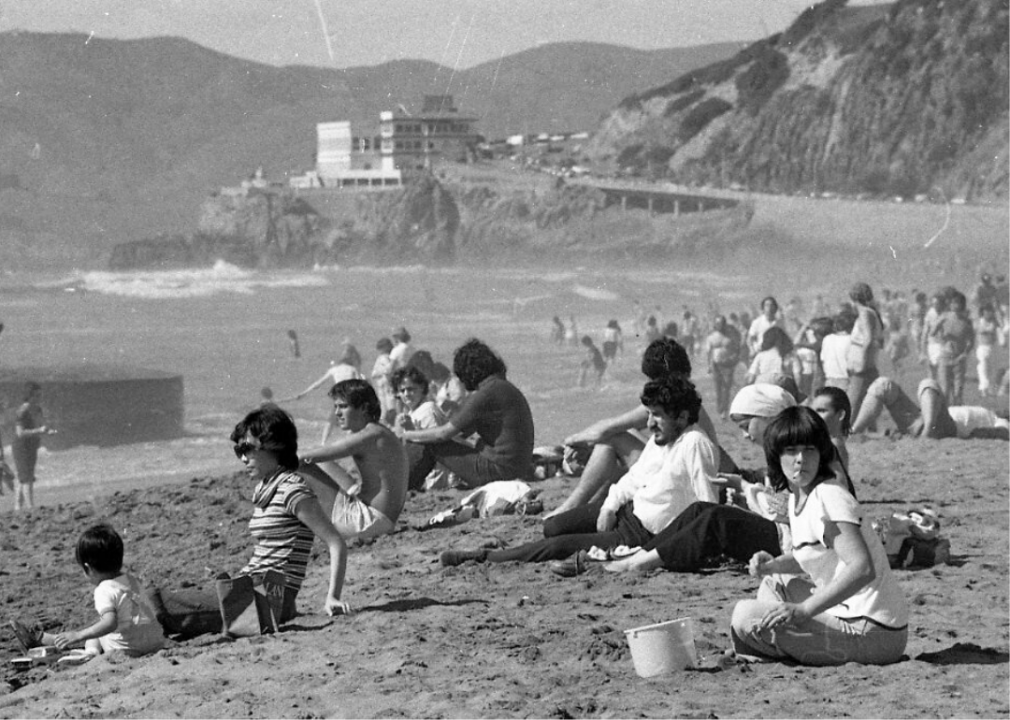
San Francisco Chronicle/Hearst Newspapers // Getty Images
1979: Hurricane David strikes
– Average summer temperature: 70.6 F (#88 warmest year; 1.1% below 100-year average)
– Maximum summer temperature: 83.4 F (#88 warmest year; 1.2% below 100-year average)
– Minimum summer temperature: 57.9 F (#83 warmest year; 0.9% below 100-year average)
– Precipitation: 8.8 inches (#26 highest; 6.1% above 100-year average)
Hurricane David made landfall in August and September of 1979. The powerful Category 5 hurricane caused more than 2,000 deaths in the Caribbean and United States.
You may also like: States with the most severe summer weather

Denver Post via Getty Images
1980: Hurricane Allen and extreme heat
– Average summer temperature: 72.4 F (#23 warmest year; 1.4% above 100-year average)
– Maximum summer temperature: 85.8 F (#16 warmest year; 1.7% above 100-year average)
– Minimum summer temperature: 59.1 F (#40 warmest year; 1.1% above 100-year average)
– Precipitation: 6.9 inches (#98 highest; 17.7% below 100-year average)
The summer of 1980 was foul for many Americans, with a sustained heat wave in Texas followed by record-setting Hurricane Allen. Even the hurricane was a fluke, originating in the Cape Verde Islands near Africa and reaching record high wind speeds until hitting the United States over Brownsville, Texas.
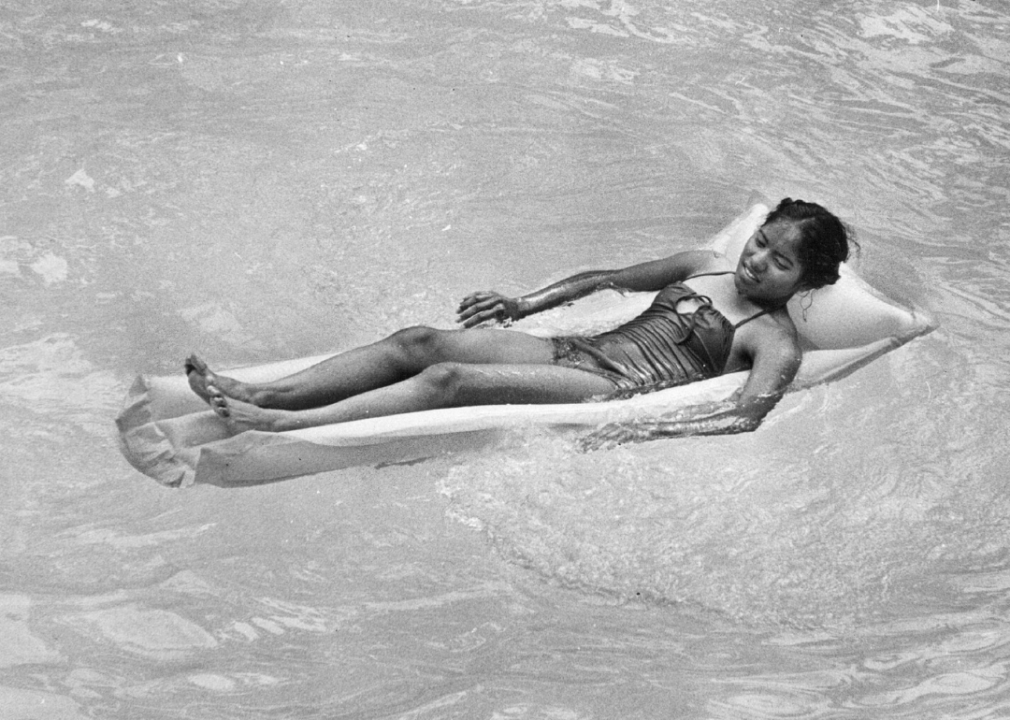
Lyn Alweis/Denver Post // Getty Images
1981: A wet, mild summer
– Average summer temperature: 72 F (#43 warmest year; 0.8% above 100-year average)
– Maximum summer temperature: 84.6 F (#54 warmest year; 0.2% above 100-year average)
– Minimum summer temperature: 59.3 F (#26 warmest year; 1.6% above 100-year average)
– Precipitation: 9.3 inches (#11 highest; 11.3% above 100-year average)
The overall temperature in 1981 was about average, with peaks and valleys around the nation that matched the heterogeneous mix around the world. A drought that blanketed the Midwest from top to bottom let up during the beginning of the summer.
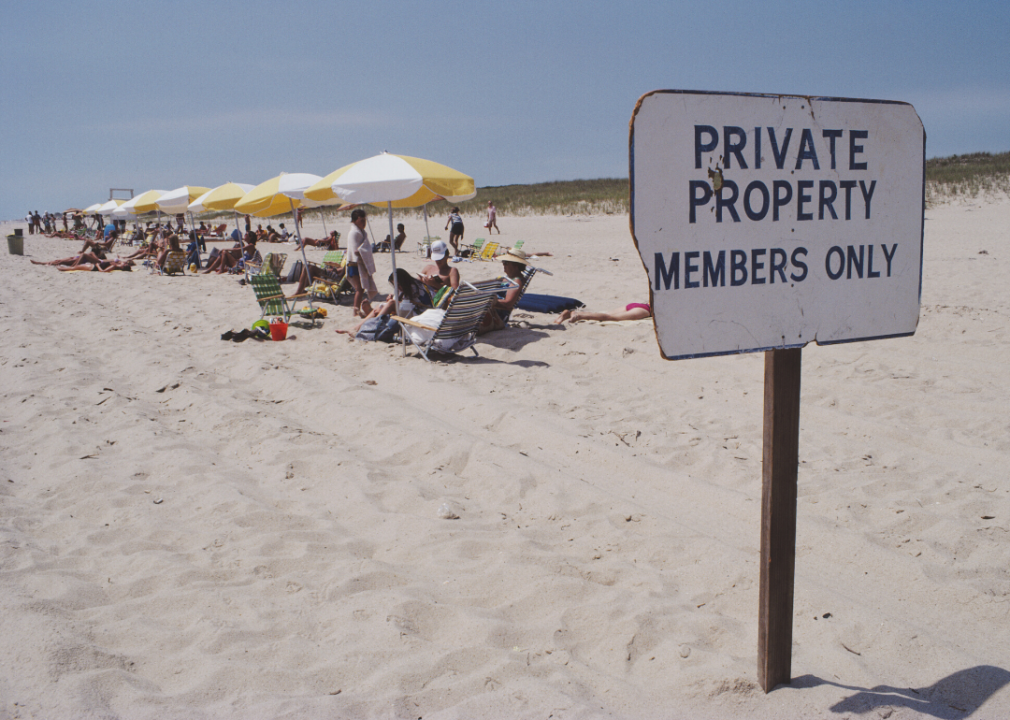
Barbara Alper // Getty Images
1982: Another El Nino
– Average summer temperature: 70.5 F (#89 warmest year; 1.2% below 100-year average)
– Maximum summer temperature: 82.9 F (#94 warmest year; 1.7% below 100-year average)
– Minimum summer temperature: 58.1 F (#78 warmest year; 0.5% below 100-year average)
– Precipitation: 8.8 inches (#28 highest; 5.9% above 100-year average)
The summer of 1982 was marked by an El Nino system that formed in March, and the warm currents rippled into world weather, including milder hurricane seasons and changes in precipitation. The phenomenon lasted into May 1983.

Joe Sohm/Visions of America/Universal Images Group // Getty Images
1983: A continuing El Nino
– Average summer temperature: 72.1 F (#36 warmest year; 0.9% above 100-year average)
– Maximum summer temperature: 84.9 F (#47 warmest year; 0.6% above 100-year average)
– Minimum summer temperature: 59.2 F (#31 warmest year; 1.4% above 100-year average)
– Precipitation: 7.4 inches (#87 highest; 11.1% below 100-year average)
One of the strongest ever El Nino systems formed in late 1982, leading to a high precipitation summer in 1983. The rest of the world continued to experience those effects as well.
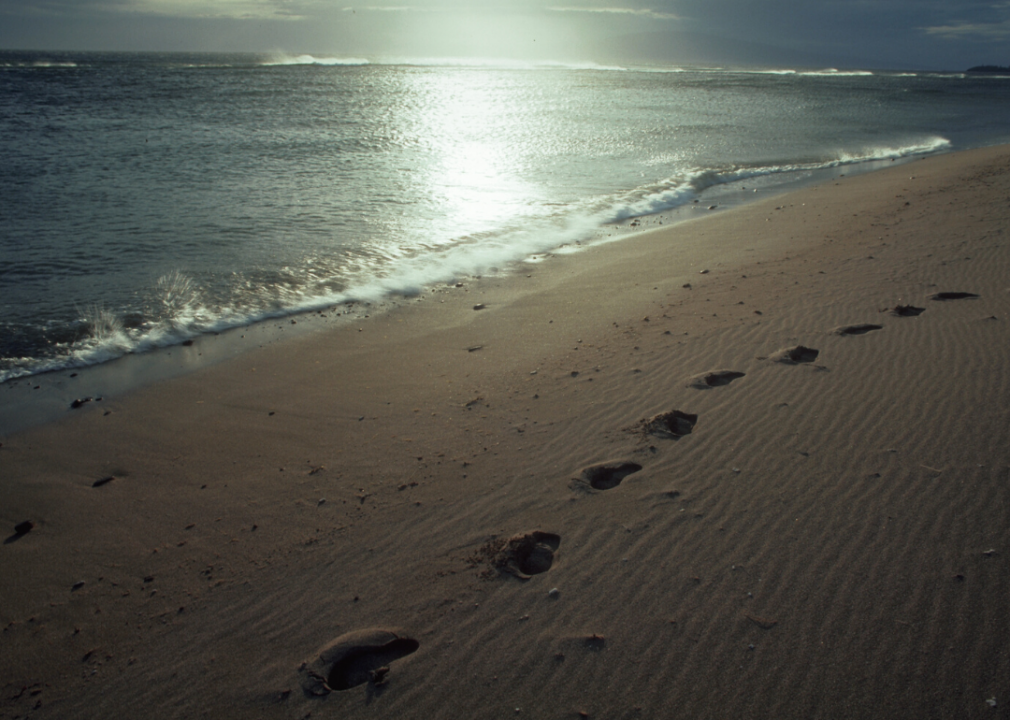
Todd Gipstein/Corbis Histrorical // Getty Images
1984: Heavy rain in the West
– Average summer temperature: 71.6 F (#57 warmest year; 0.3% above 100-year average)
– Maximum summer temperature: 84.4 F (#67 warmest year; 0% below 100-year average)
– Minimum summer temperature: 58.9 F (#43 warmest year; 0.9% above 100-year average)
– Precipitation: 8.2 inches (#66 highest; 1.6% below 100-year average)
The summer of 1984 was marked by stark areas of colder and warmer than average temperatures around the world. Within the United States, heavy precipitation fell in the western half.
You may also like: 15 wild weather phenomena
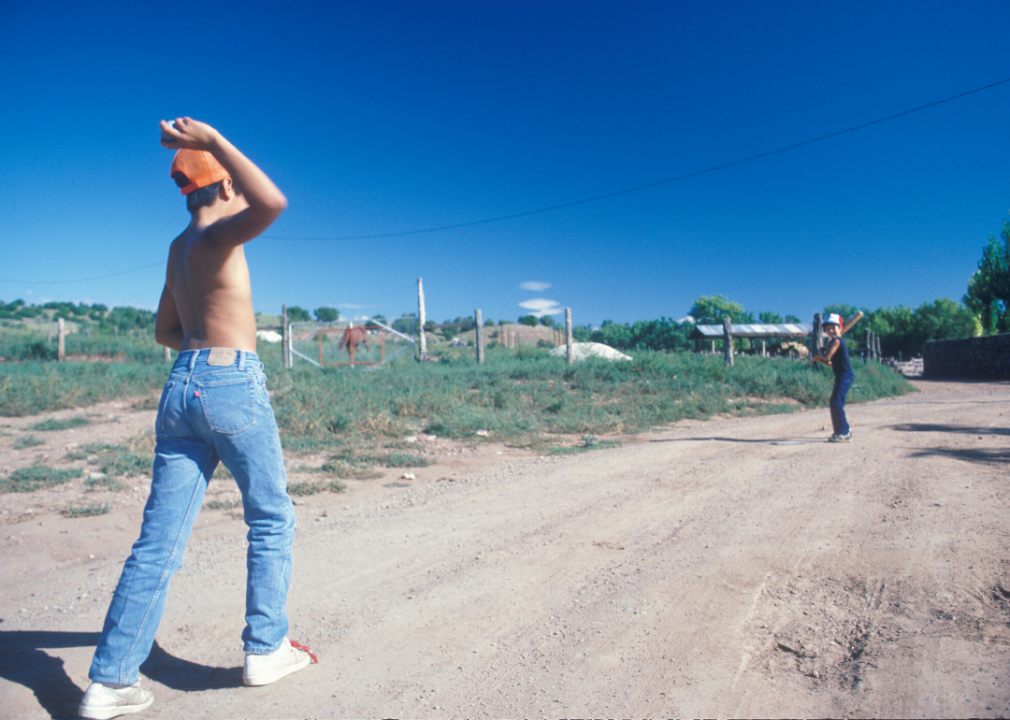
John Sohm/Visions of America // Getty Images
1985: Destructive Hurricane Gloria
– Average summer temperature: 71.1 F (#78 warmest year; 0.5% below 100-year average)
– Maximum summer temperature: 84.2 F (#73 warmest year; 0.3% below 100-year average)
– Minimum summer temperature: 58 F (#82 warmest year; 0.8% below 100-year average)
– Precipitation: 8.3 inches (#60 highest; 0.6% below 100-year average)
Hurricane Gloria was “just” a Category 4 storm, but when it struck New York City in September 1985, it was the first storm to do so in more than a decade. It moved south and also struck the Carolinas.
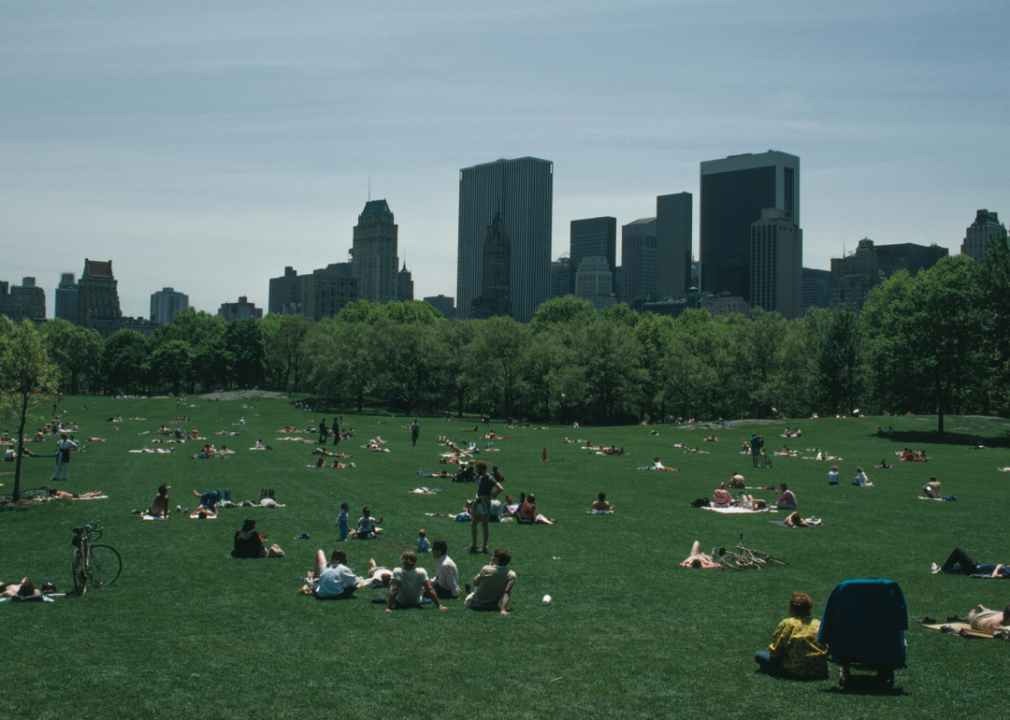
Alfred Gescheidt // Getty Images
1986: Dry conditions in the South
– Average summer temperature: 71.9 F (#47 warmest year; 0.7% above 100-year average)
– Maximum summer temperature: 84.6 F (#53 warmest year; 0.3% above 100-year average)
– Minimum summer temperature: 59.2 F (#34 warmest year; 1.3% above 100-year average)
– Precipitation: 8.6 inches (#40 highest; 3.4% above 100-year average)
In the average-temperature summer of 1986, the United States had some areas of warm temperatures and some of lower. Drought conditions affected the South, and the Midwest grew wetter as the summer progressed.

picture alliance // Getty Images
1987: Average across the board
– Average summer temperature: 71.8 F (#52 warmest year; 0.6% above 100-year average)
– Maximum summer temperature: 84.6 F (#57 warmest year; 0.2% above 100-year average)
– Minimum summer temperature: 59 F (#41 warmest year; 1% above 100-year average)
– Precipitation: 8.4 inches (#52 highest; 0.7% above 100-year average)
The summer of 1987 worked out to average temperatures, but combined areas that were very different. The central United States experienced higher than usual precipitation while each coast experienced some drought conditions.
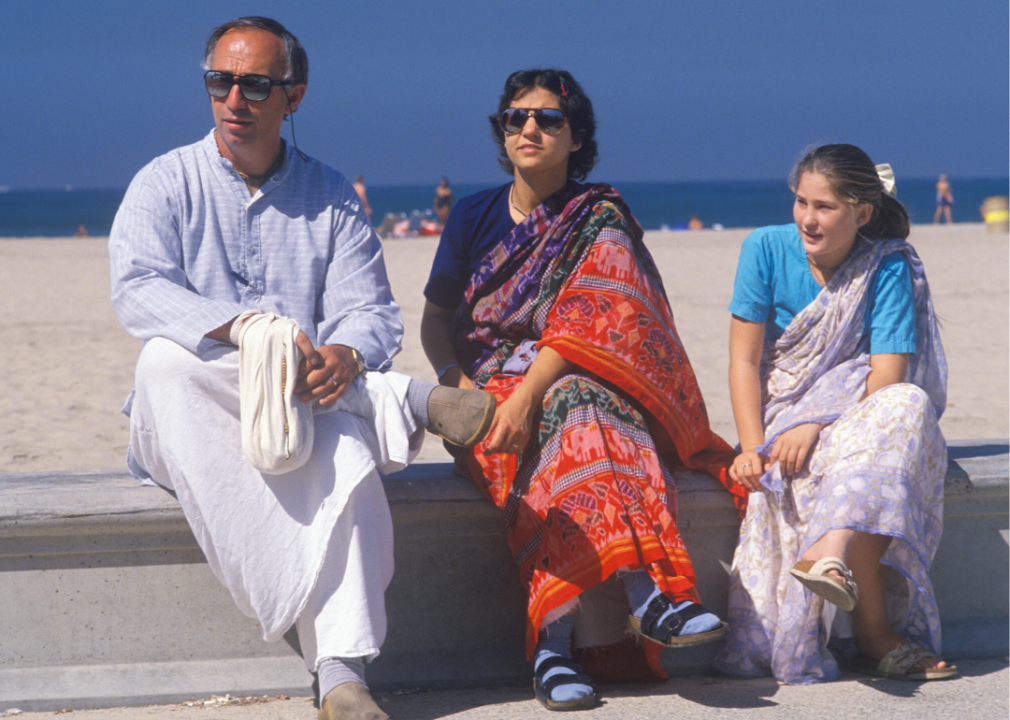
John Sohm/Visions of America // Getty Images
1988: Hurricane Gilbert clears a path
– Average summer temperature: 73.1 F (#9 warmest year; 2.4% above 100-year average)
– Maximum summer temperature: 86.7 F (#4 warmest year; 2.7% above 100-year average)
– Minimum summer temperature: 59.5 F (#19 warmest year; 1.9% above 100-year average)
– Precipitation: 6.9 inches (#97 highest; 17.3% below 100-year average)
Gigantic Hurricane Gilbert struck the Caribbean and Mexico before passing over and into the Midwestern United States. Gilbert caused massive destruction and the storm name was retired after 1988.
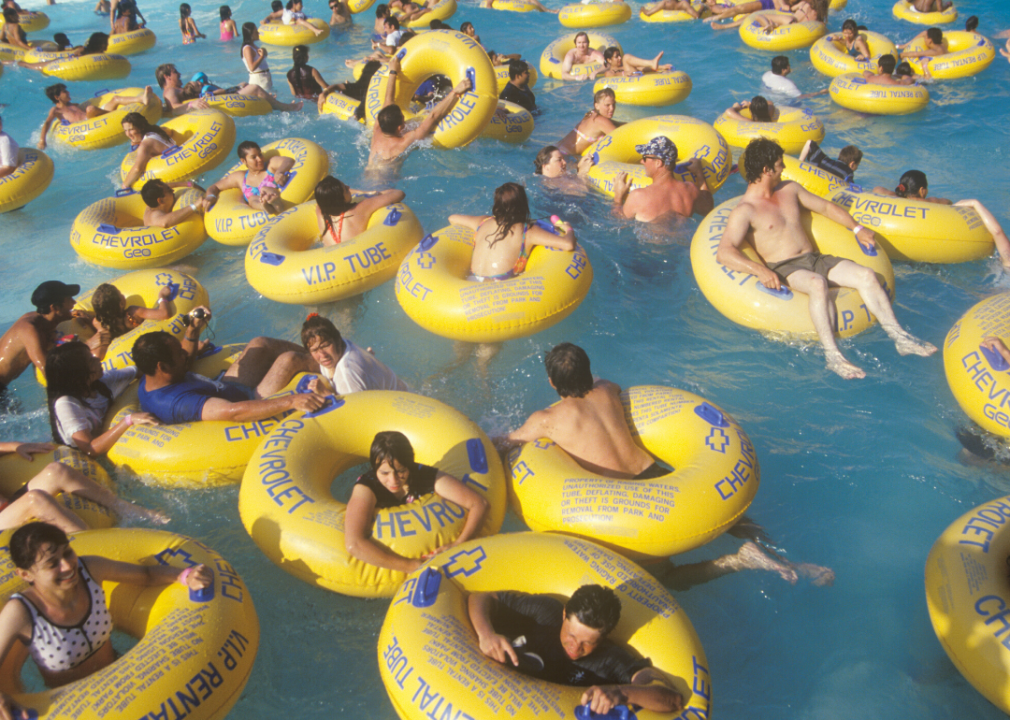
John Sohm/Visions of America // Getty Images
1989: A warm and cold combo
– Average summer temperature: 71.2 F (#72 warmest year; 0.3% below 100-year average)
– Maximum summer temperature: 83.8 F (#80 warmest year; 0.8% below 100-year average)
– Minimum summer temperature: 58.7 F (#53 warmest year; 0.5% above 100-year average)
– Precipitation: 9.4 inches (#8 highest; 12.9% above 100-year average)
Most of the United States experienced average temperatures during the summer of 1989. The overall temperature was brought down by the central United States, where cold temperatures combined, improbably, with drought conditions.
You may also like: The best streaming services for sports in 2021

Camerique/ClassicStock // Getty Images
1990: Widespread drought conditions
– Average summer temperature: 71.9 F (#45 warmest year; 0.7% above 100-year average)
– Maximum summer temperature: 84.6 F (#50 warmest year; 0.3% above 100-year average)
– Minimum summer temperature: 59.2 F (#32 warmest year; 1.4% above 100-year average)
– Precipitation: 8.1 inches (#71 highest; 2.8% below 100-year average)
The western United States and most of Florida experienced rolling drought conditions during the summer of 1990. At the same time, heavy rain fell on the Rust Belt from the Chicago area all the way through Vermont, New Hampshire, and Maine.

Douglas Peebles // Getty Images
1991: Heavy rain in the Midwest
– Average summer temperature: 72 F (#38 warmest year; 0.8% above 100-year average)
– Maximum summer temperature: 84.6 F (#58 warmest year; 0.2% above 100-year average)
– Minimum summer temperature: 59.4 F (#23 warmest year; 1.7% above 100-year average)
– Precipitation: 8.1 inches (#68 highest; 2.2% below 100-year average)
Most of both the United States and Canada were warmer than average in the summer of 1991. Areas of drought appeared in the South and elsewhere, with heavy rain in the Midwest and Southwest as the summer continued.
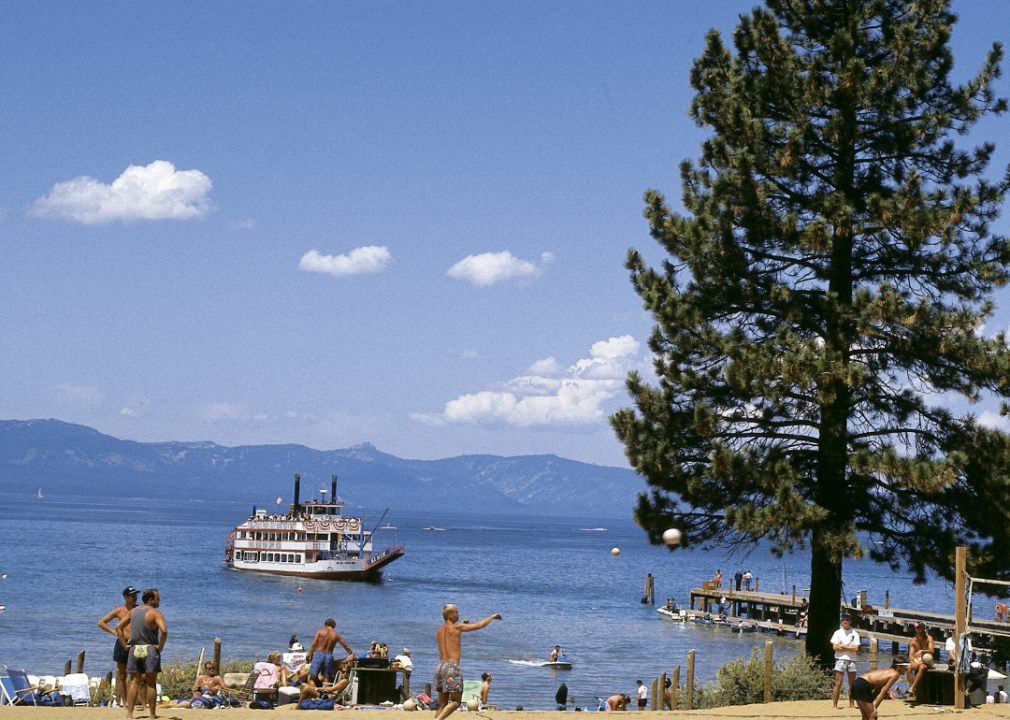
Independent Picture Group/Universal Images Group // Getty Images
1992: Hurricane Andrew strikes Florida
– Average summer temperature: 69.5 F (#100 warmest year; 2.6% below 100-year average)
– Maximum summer temperature: 81.7 F (#100 warmest year; 3.2% below 100-year average)
– Minimum summer temperature: 57.3 F (#98 warmest year; 2% below 100-year average)
– Precipitation: 9.9 inches (#2 highest; 19.5% above 100-year average)
In August 1992, Hurricane Andrew tore a swath across the Caribbean, Florida, and Louisiana. After causing more than $26 billion worth of damage in the United States and dozens of deaths, Andrew was retired from hurricane naming.
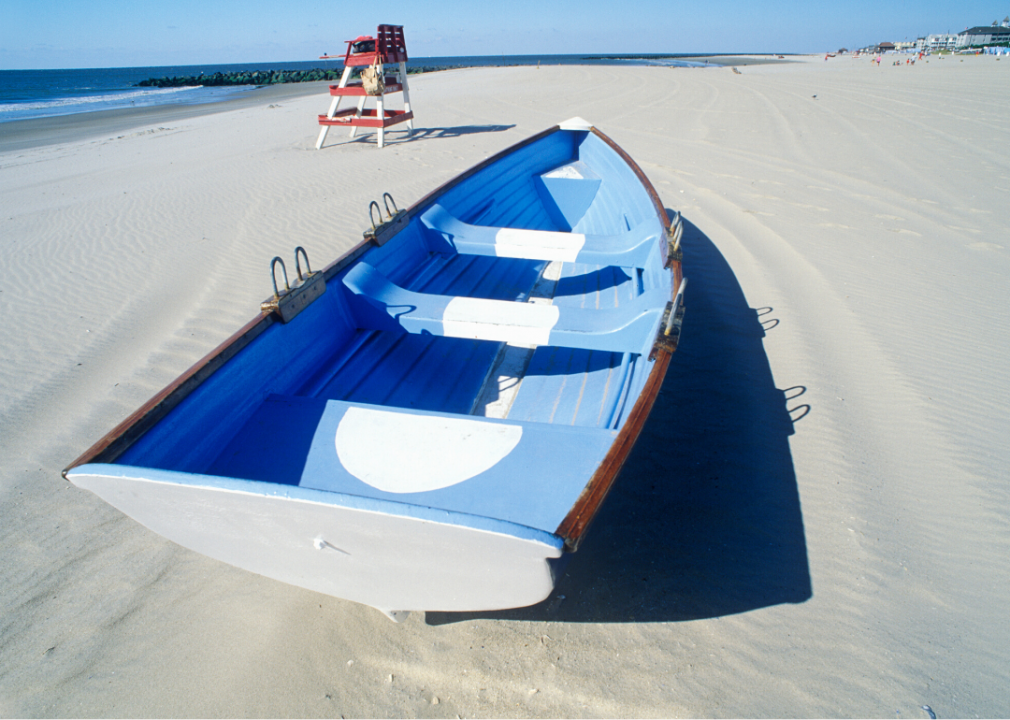
John Sohm/Visions of America // Getty Images
1993: A rainy summer in the Southwest
– Average summer temperature: 70.4 F (#92 warmest year; 1.4% below 100-year average)
– Maximum summer temperature: 82.5 F (#98 warmest year; 2.2% below 100-year average)
– Minimum summer temperature: 58.3 F (#69 warmest year; 0.2% below 100-year average)
– Precipitation: 9.7 inches (#4 highest; 16.3% above 100-year average)
The summer of 1993 continued a very wet and cool year in the United States. The high precipitation touched almost all regions, including the desert Southwest.
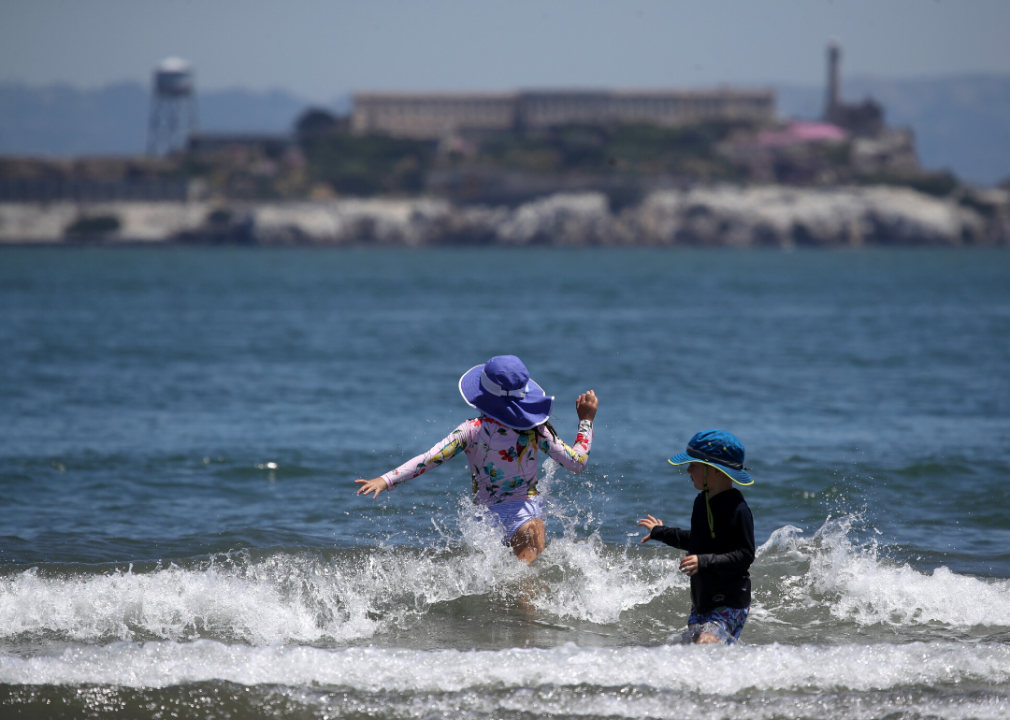
Justin Sullivan // Getty Images
1994: Extreme drought and heavy rain
– Average summer temperature: 72.3 F (#27 warmest year; 1.2% above 100-year average)
– Maximum summer temperature: 85.2 F (#29 warmest year; 1% above 100-year average)
– Minimum summer temperature: 59.3 F (#28 warmest year; 1.5% above 100-year average)
– Precipitation: 8.5 inches (#45 highest; 2.5% above 100-year average)
The summer of 1994 was warm overall, but represented a split in the United States, where the western half was warm and the eastern portion was cooler. The West had areas of extreme drought while the Midwest had heavy rain.
You may also like: 50 common weather terms, explained
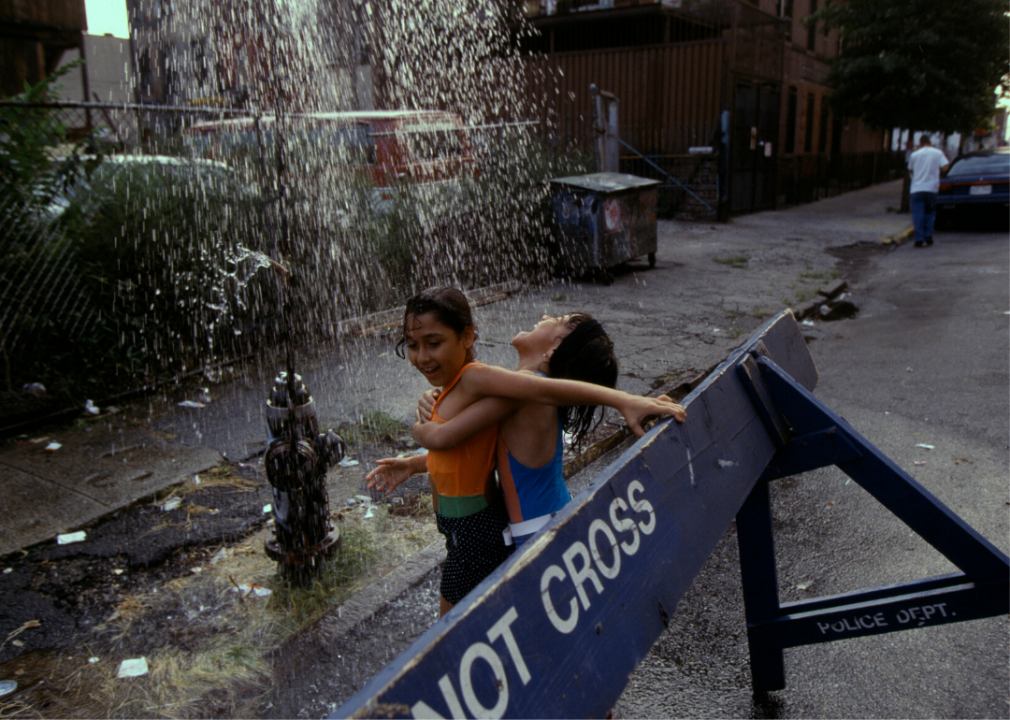
Andrew Lichtenstein/Corbis Historical // Getty Images
1995: Hurricanes Opal, Luis, and Marilyn
– Average summer temperature: 71.8 F (#52 warmest year; 0.6% above 100-year average)
– Maximum summer temperature: 84.5 F (#59 warmest year; 0.1% above 100-year average)
– Minimum summer temperature: 59.1 F (#35 warmest year; 1.2% above 100-year average)
– Precipitation: 8.5 inches (#44 highest; 2.6% above 100-year average)
As part of a very packed hurricane season, Hurricane Opal struck Mexico and the southern United States. Hurricanes Luis and Marilyn also struck and heavily damaged islands in the Caribbean.

Joe Sohm/Visions of America // Getty Images
1996: Heavy rain in the Northwest
– Average summer temperature: 72 F (#40 warmest year; 0.8% above 100-year average)
– Maximum summer temperature: 84.7 F (#48 warmest year; 0.4% above 100-year average)
– Minimum summer temperature: 59.2 F (#30 warmest year; 1.4% above 100-year average)
– Precipitation: 8.7 inches (#37 highest; 4% above 100-year average)
In the United States, the summer of 1996 presented average temperatures with fewer than usual extreme temperatures around the world. There was heavy rain in the Northwest and severe drought conditions in the Southwest.
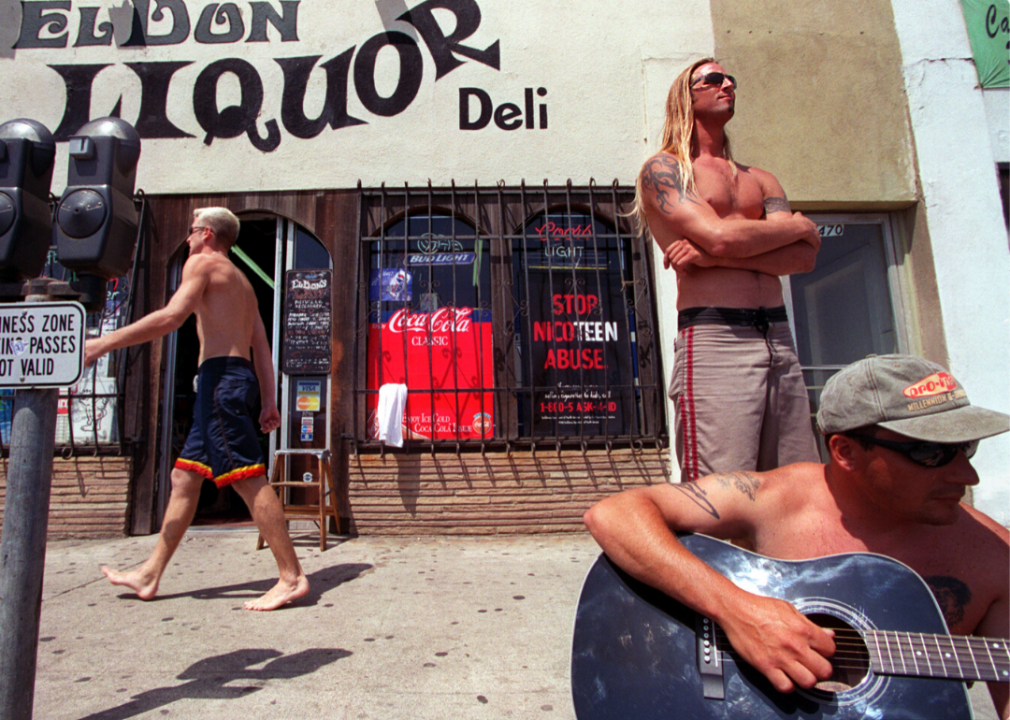
Rick Loomis/Los Angeles Times // Getty Images
1997: A huge El Nino
– Average summer temperature: 71.1 F (#77 warmest year; 0.4% below 100-year average)
– Maximum summer temperature: 83.5 F (#86 warmest year; 1.1% below 100-year average)
– Minimum summer temperature: 58.7 F (#54 warmest year; 0.4% above 100-year average)
– Precipitation: 8.8 inches (#29 highest; 5.6% above 100-year average)
Children born in 1997 were blessed by one of the most newsmaking weather events in modern memory, beginning in April of 1997 and continuing for the next year. One of the most powerful El Nino warm current phenomena ever recorded lashed the world with severe and unseasonable weather all year.
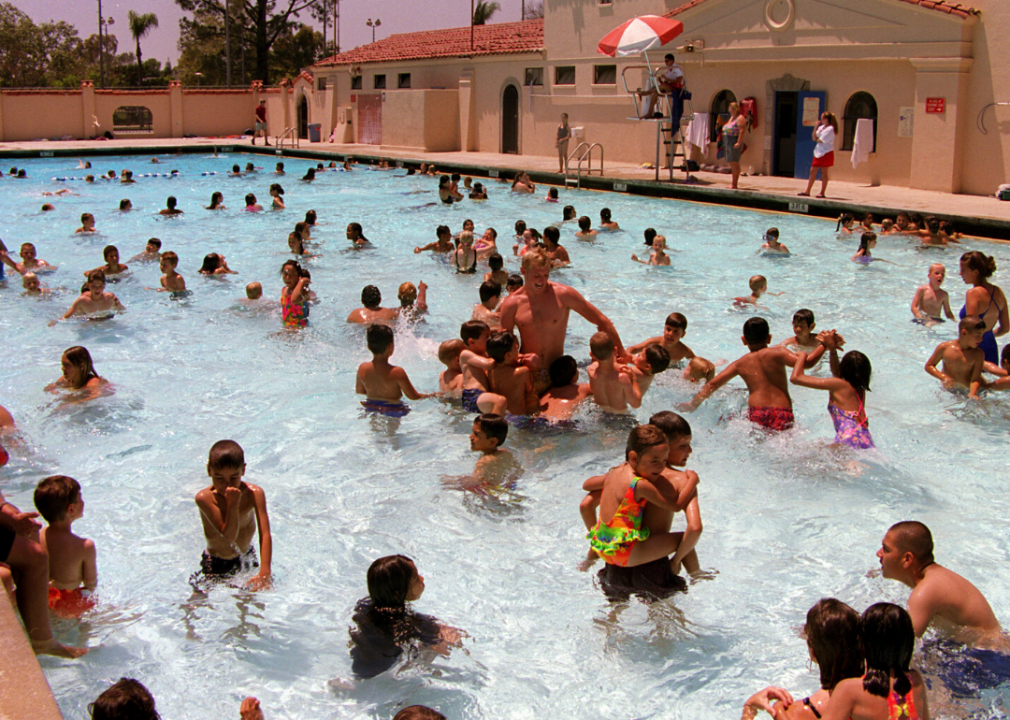
Robert Lachmann/Los Angeles Times // Getty Images
1998: Deadly Hurricane Mitch
– Average summer temperature: 72.6 F (#21 warmest year; 1.6% above 100-year average)
– Maximum summer temperature: 85.1 F (#35 warmest year; 0.9% above 100-year average)
– Minimum summer temperature: 60 F (#13 warmest year; 2.6% above 100-year average)
– Precipitation: 8.6 inches (#40 highest; 3.4% above 100-year average)
Hurricane Mitch struck later in the fall of 1998 and killed more than 10,000 people in Central America, making it one of the deadliest hurricanes in recorded history. And following the powerful 1997 El Nino, 1998 brought the first of a nearly three-year La Nina phenomenon.

Camerique/ClassicStock // Getty Images
1999: Drought in the East
– Average summer temperature: 71.8 F (#49 warmest year; 0.6% above 100-year average)
– Maximum summer temperature: 84.4 F (#63 warmest year; 0% below 100-year average)
– Minimum summer temperature: 59.3 F (#29 warmest year; 1.5% above 100-year average)
– Precipitation: 8.2 inches (#66 highest; 1.6% below 100-year average)
In 1999, the summer temperatures were average, but represented a split within the United States. The warmer eastern half experienced some drought conditions while the cooler central and western portions experienced more precipitation.
You may also like: How weather has shaped human history
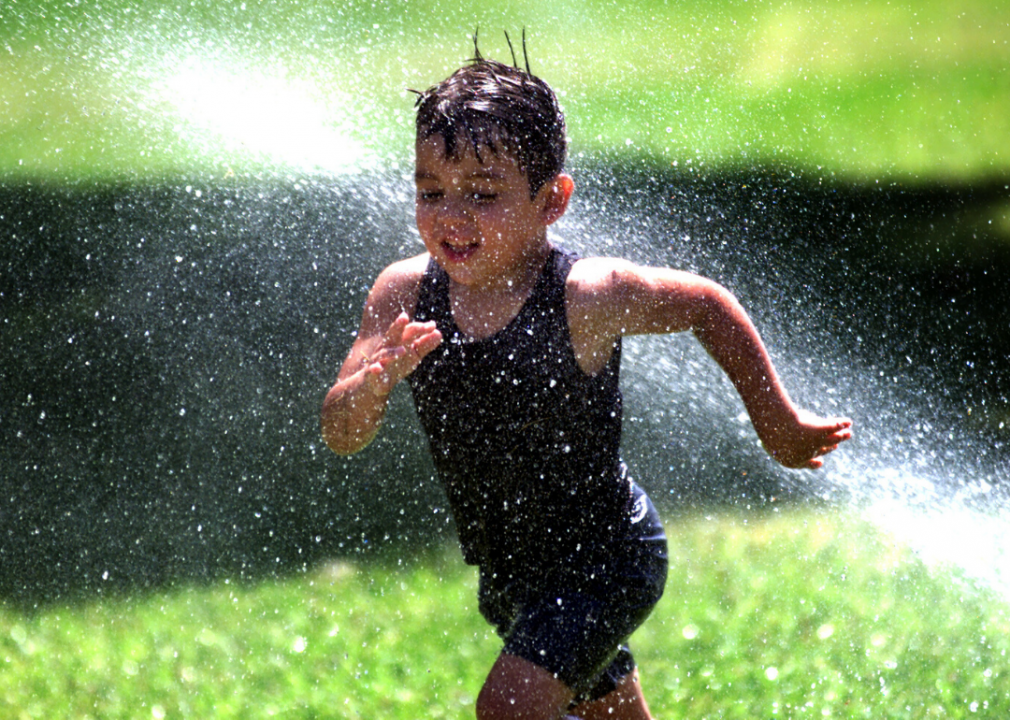
Joel P. Lugavere/Los Angeles Times // Getty Images
2000: Even Antarctica is warm
– Average summer temperature: 72.3 F (#26 warmest year; 1.3% above 100-year average)
– Maximum summer temperature: 85.3 F (#26 warmest year; 1.1% above 100-year average)
– Minimum summer temperature: 59.3 F (#24 warmest year; 1.6% above 100-year average)
– Precipitation: 7.7 inches (#80 highest; 7.9% below 100-year average)
The summer of 2000 was hot and dry, with drought conditions across much of the United States. The same was true around much of the world, including unseasonably extreme temperatures in Antarctica.

Ken Lubas/Los Angeles Times // Getty Images
2001: Extremely wet in the Midwest
– Average summer temperature: 72.7 F (#18 warmest year; 1.8% above 100-year average)
– Maximum summer temperature: 85.5 F (#18 warmest year; 1.3% above 100-year average)
– Minimum summer temperature: 59.8 F (#15 warmest year; 2.4% above 100-year average)
– Precipitation: 8.3 inches (#61 highest; 0.8% below 100-year average)
The year 2001 saw another warm summer, with high temperatures around the country, but concentrated in the West. There were drought conditions in the West and along the Atlantic coast, with some very wet portions of the Midwest in between.

Ricardo DeAratanha/Los Angeles Times // Getty Images
2002: Widespread droughts around the US
– Average summer temperature: 73.2 F (#8 warmest year; 2.5% above 100-year average)
– Maximum summer temperature: 86.2 F (#9 warmest year; 2.2% above 100-year average)
– Minimum summer temperature: 60.1 F (#9 warmest year; 3% above 100-year average)
– Precipitation: 7.6 inches (#83 highest; 9.1% below 100-year average)
The summer of 2002 was very warm around the nation. Because of that, the western half of the United States and much of the South experienced extreme drought conditions.

Glenn Koenig/Los Angeles Times // Getty Images
2003: Heavy damage from Hurricane Isabel
– Average summer temperature: 72.7 F (#15 warmest year; 1.8% above 100-year average)
– Maximum summer temperature: 85.6 F (#17 warmest year; 1.4% above 100-year average)
– Minimum summer temperature: 59.9 F (#14 warmest year; 2.5% above 100-year average)
– Precipitation: 8.7 inches (#37 highest; 4% above 100-year average)
Hurricane Isabel struck and damaged much of the Atlantic seaboard of the United States, causing deaths in both the United States and Canada. The storm did more than $3 billion in damage that year.
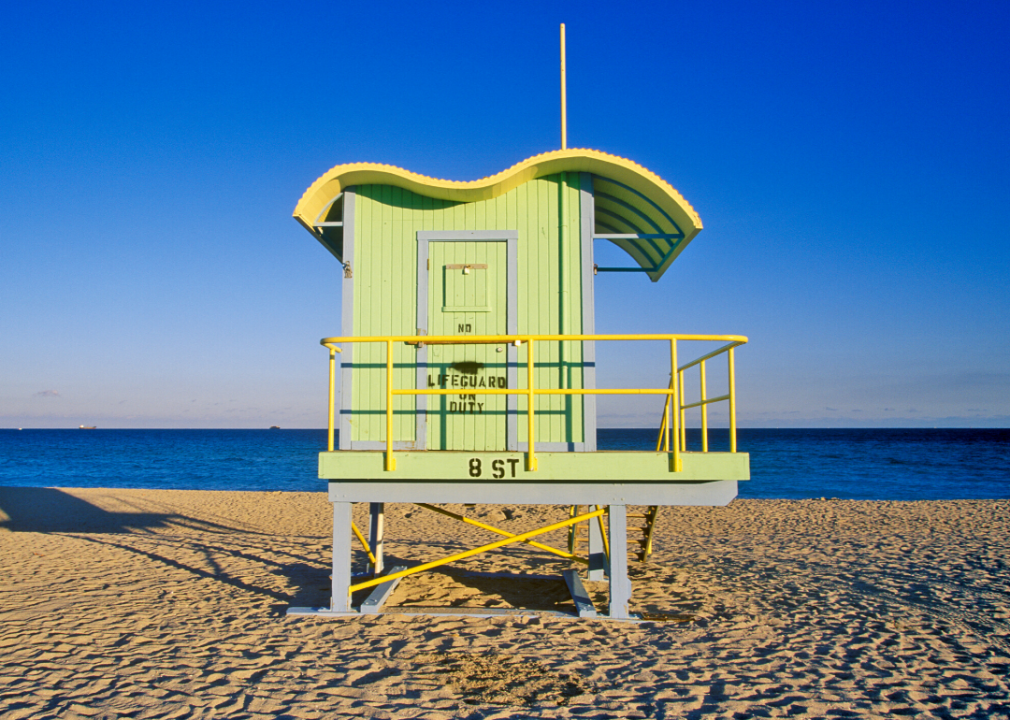
Joe Sohm/Visions of America // Getty Images
2004: Hurricane Ivan damages the Caribbean
– Average summer temperature: 70.4 F (#94 warmest year; 1.4% below 100-year average)
– Maximum summer temperature: 82.7 F (#97 warmest year; 2% below 100-year average)
– Minimum summer temperature: 58 F (#80 warmest year; 0.7% below 100-year average)
– Precipitation: 9.6 inches (#5 highest; 15.4% above 100-year average)
Category 5 Hurricane Ivan struck and heavily damaged islands in the Caribbean like Jamaica and Grenada before eventually landing in Florida. The name Ivan was retired after 2004.
You may also like: 30 incredible photos that show the true power of nature

John Greim/Lightrocket // Getty Images
2005: Hurricane Katrina strikes
– Average summer temperature: 72.6 F (#19 warmest year; 1.6% above 100-year average)
– Maximum summer temperature: 85.3 F (#25 warmest year; 1.1% above 100-year average)
– Minimum summer temperature: 59.8 F (#15 warmest year; 2.4% above 100-year average)
– Precipitation: 8.8 inches (#26 highest; 6.1% above 100-year average)
In August 2005, destructive Hurricane Katrina hit the Gulf Coast of the United States and caused more than 1,000 deaths and over $100 billion in damage. The legacy of the many deaths and extensive damage to New Orleans’ infrastructure, including its fragile levee system, persists today.
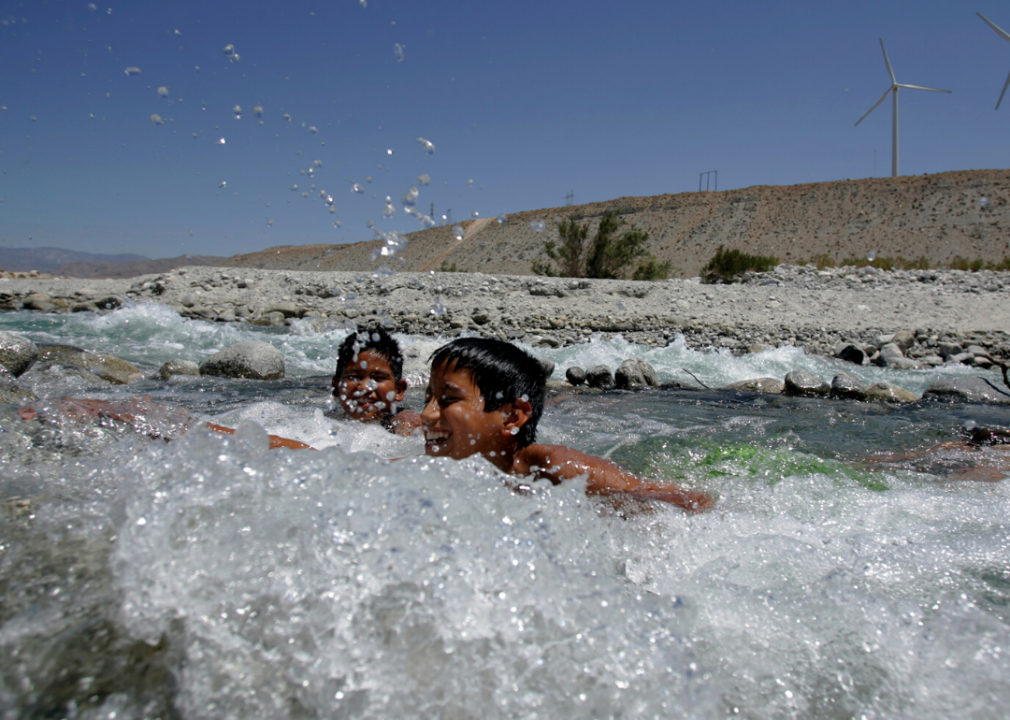
Gina Ferazzi/Los Angeles Times // Getty Images
2006: Extreme drought in the South
– Average summer temperature: 73.5 F (#5 warmest year; 2.9% above 100-year average)
– Maximum summer temperature: 86.6 F (#6 warmest year; 2.6% above 100-year average)
– Minimum summer temperature: 60.4 F (#5 warmest year; 3.5% above 100-year average)
– Precipitation: 7.8 inches (#78 highest; 6% below 100-year average)
The hot summer of 2006 registered as one of the highest above average in this list. The summer was marked by extreme drought conditions in much of the southern half of the nation.

Construction Photograph/Avalon/Hulton Archive // Getty Images
2007: Giant Hurricane Dean
– Average summer temperature: 73.1 F (#11 warmest year; 2.3% above 100-year average)
– Maximum summer temperature: 86 F (#13 warmest year; 1.8% above 100-year average)
– Minimum summer temperature: 60.2 F (#8 warmest year; 3.1% above 100-year average)
– Precipitation: 8.4 inches (#51 highest; 0.8% above 100-year average)
In August 2007, huge Hurricane Dean swept through the Caribbean. Although the Category 5 storm killed dozens of people and caused a lot of harm, it missed many of the most populated areas and caused less damage than experts feared.

Lightrocket // Getty Images
2008: A rainy Midwestern summer
– Average summer temperature: 72 F (#38 warmest year; 0.8% above 100-year average)
– Maximum summer temperature: 84.9 F (#46 warmest year; 0.6% above 100-year average)
– Minimum summer temperature: 59.1 F (#38 warmest year; 1.2% above 100-year average)
– Precipitation: 8.9 inches (#25 highest; 6.4% above 100-year average)
The overall temperatures of the summer of 2008 work out to about average. The coasts were warm and dry, while the Midwest was drenched with heavy rain.
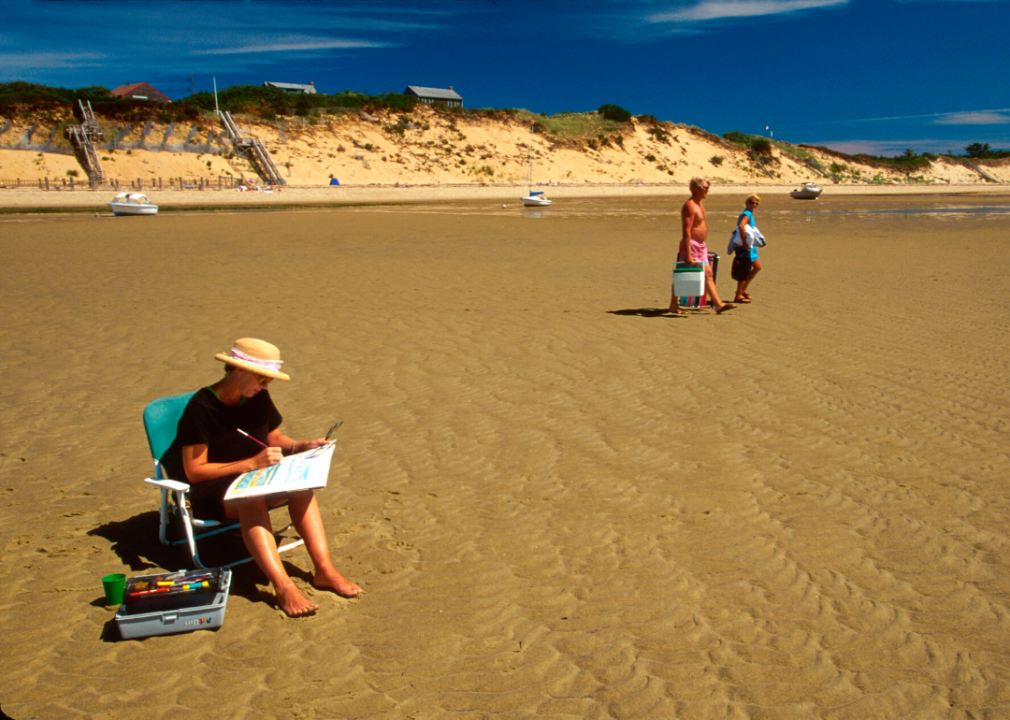
Jeff Greenburg/Universal Images Group // Getty Images
2009: Droughts on the coasts
– Average summer temperature: 71 F (#79 warmest year; 0.5% below 100-year average)
– Maximum summer temperature: 83.5 F (#84 warmest year; 1.1% below 100-year average)
– Minimum summer temperature: 58.5 F (#61 warmest year; 0.2% above 100-year average)
– Precipitation: 8.8 inches (#30 highest; 5.4% above 100-year average)
The overall temperatures in the summer of 2009 were cooler than average. The southern edge of the country experienced drought conditions while the greater Midwest experienced heavy rain all summer.
You may also like: 20 safety preparations for the weather this summer

Glenn Koenig/Los Angeles Times // Getty Images
2010: A hot, dry southern summer
– Average summer temperature: 73.1 F (#10 warmest year; 2.3% above 100-year average)
– Maximum summer temperature: 85.5 F (#21 warmest year; 1.3% above 100-year average)
– Minimum summer temperature: 60.7 F (#3 warmest year; 3.9% above 100-year average)
– Precipitation: 9.3 inches (#9 highest; 12% above 100-year average)
In a quite warm summer, the hottest extremes were in the eastern half of the United States. There were also moderate drought conditions in part of the South.
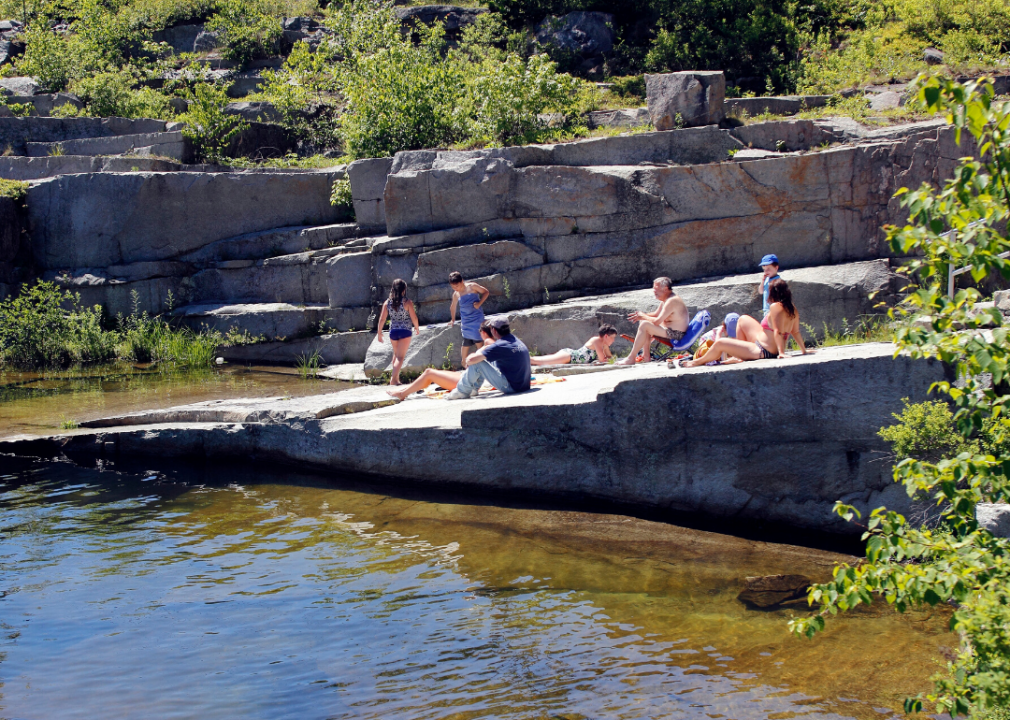
Education Images/Universal Images Group // Getty Images
2011: Very warm and very divided
– Average summer temperature: 73.7 F (#3 warmest year; 3.1% above 100-year average)
– Maximum summer temperature: 86.7 F (#5 warmest year; 2.7% above 100-year average)
– Minimum summer temperature: 60.7 F (#4 warmest year; 3.8% above 100-year average)
– Precipitation: 7.4 inches (#88 highest; 11.5% below 100-year average)
The summer of 2011 was extreme in temperature and in precipitation. Temperatures around the United States were all higher than average, and while the northern half of the country experienced heavy rain, the southern half experienced extreme drought.
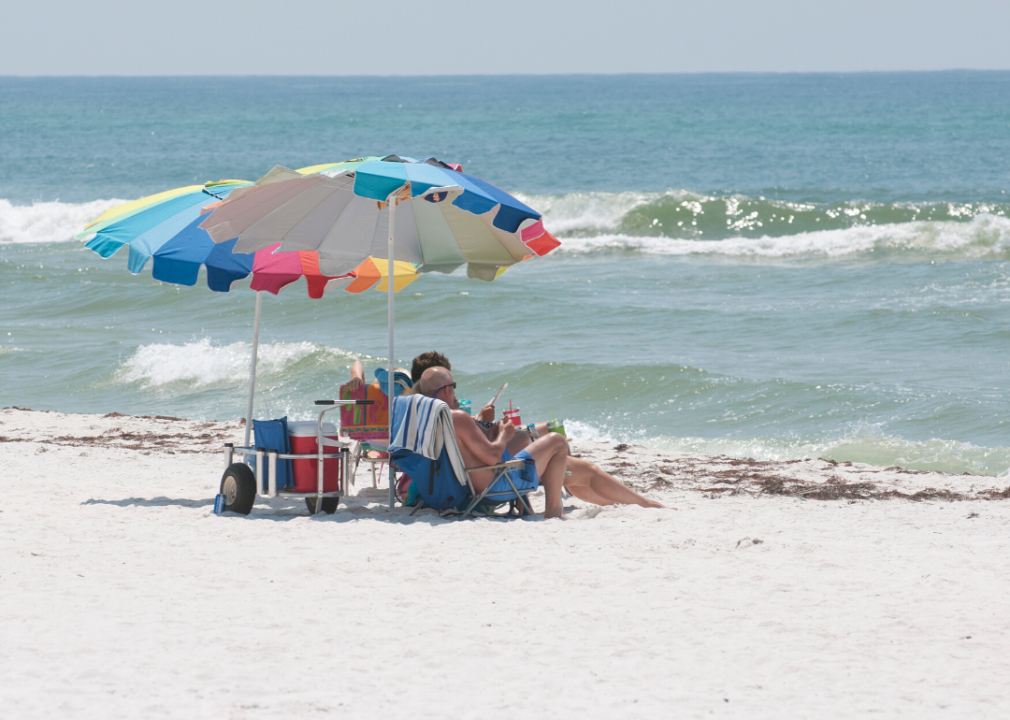
Education Images/Universal Images Group // Getty Images
2012: Dry conditions in the Rockies
– Average summer temperature: 73.7 F (#2 warmest year; 3.2% above 100-year average)
– Maximum summer temperature: 87.2 F (#3 warmest year; 3.3% above 100-year average)
– Minimum summer temperature: 60.2 F (#7 warmest year; 3.1% above 100-year average)
– Precipitation: 7.2 inches (#90 highest; 13.2% below 100-year average)
The summer of 2012 is one of the warmest and driest on record. The Rocky Mountain states experienced extreme drought conditions for most of the summer.

Andia/Universal Images Group // Getty Images
2013: Drought in the West
– Average summer temperature: 72.5 F (#22 warmest year; 1.6% above 100-year average)
– Maximum summer temperature: 84.9 F (#43 warmest year; 0.7% above 100-year average)
– Minimum summer temperature: 60.1 F (#10 warmest year; 2.9% above 100-year average)
– Precipitation: 9.2 inches (#12 highest; 11.1% above 100-year average)
Temperatures were high-average in the summer of 2013. Drought conditions continued in the western United States, which experienced higher temperatures than the eastern half.
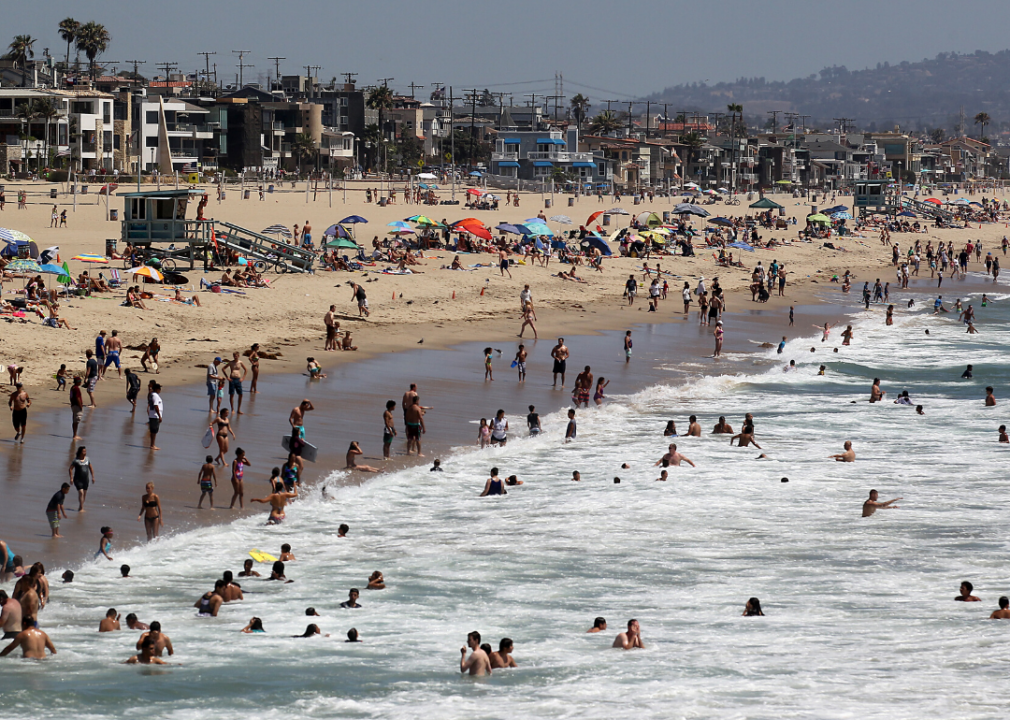
Luis Sinco/Los Angeles Times // Getty Images
2014: Hurricane Odile hits Mexico
– Average summer temperature: 71.7 F (#55 warmest year; 0.4% above 100-year average)
– Maximum summer temperature: 83.9 F (#77 warmest year; 0.5% below 100-year average)
– Minimum summer temperature: 59.5 F (#22 warmest year; 1.8% above 100-year average)
– Precipitation: 9.4 inches (#7 highest; 13% above 100-year average)
Hurricane Odile struck the Mexican states of Baja California and Baja California Sur in September 2014. The storm caused damage and some deaths in Mexico before weakening and traveling across the southwestern United States.
You may also like: 54 American cities with dangerous ozone conditions

Ken Lubas/Los Angeles Times // Getty Images
2015: A large El Nino
– Average summer temperature: 72.8 F (#14 warmest year; 1.9% above 100-year average)
– Maximum summer temperature: 85.1 F (#35 warmest year; 0.9% above 100-year average)
– Minimum summer temperature: 60.3 F (#6 warmest year; 3.3% above 100-year average)
– Precipitation: 9.2 inches (#14 highest; 10.5% above 100-year average)
An El Nino began at the end of 2014 and continued through all of 2015. The ENSO blog likened it to a traffic rerouting on a global scale, causing unforeseen circumstances everywhere as a result of extensive changes and disruption.

The Washington Post // Getty Images
2016: Very hot with heavy rain
– Average summer temperature: 73.5 F (#6 warmest year; 2.9% above 100-year average)
– Maximum summer temperature: 86.2 F (#10 warmest year; 2.2% above 100-year average)
– Minimum summer temperature: 60.8 F (#2 warmest year; 4.1% above 100-year average)
– Precipitation: 8.9 inches (#24 highest; 6.6% above 100-year average)
The summer of 2016 brought temperatures up to the high range, in a year when global-reported extremes were also on the warm side. There were pockets of extreme drought in the United States, but the central United States was drenched with rain all summer long.
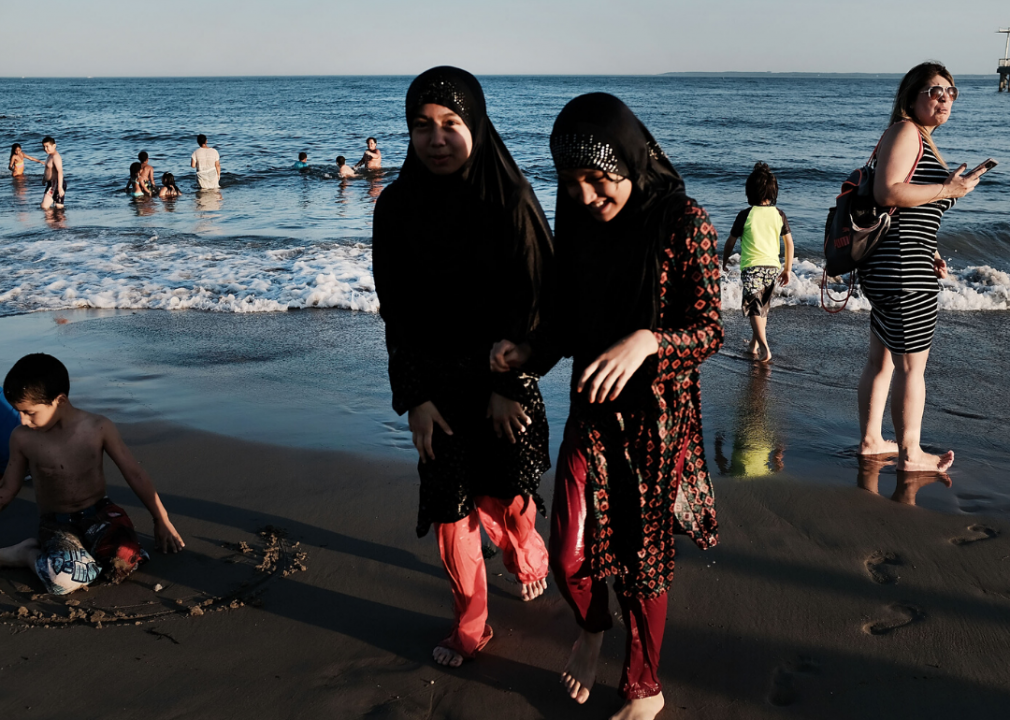
Spencer Platt // Getty Images
2017: Hurricanes Irma and Maria
– Average summer temperature: 72.7 F (#16 warmest year; 1.8% above 100-year average)
– Maximum summer temperature: 85.4 F (#23 warmest year; 1.1% above 100-year average)
– Minimum summer temperature: 60 F (#12 warmest year; 2.8% above 100-year average)
– Precipitation: 9.3 inches (#10 highest; 11.7% above 100-year average)
Hurricanes Irma and Maria both reached Category 5 status—Irma in at the end of August and Maria at the end of September. Both storms were severe and caused extensive damage, and both names were retired from the hurricane names list.
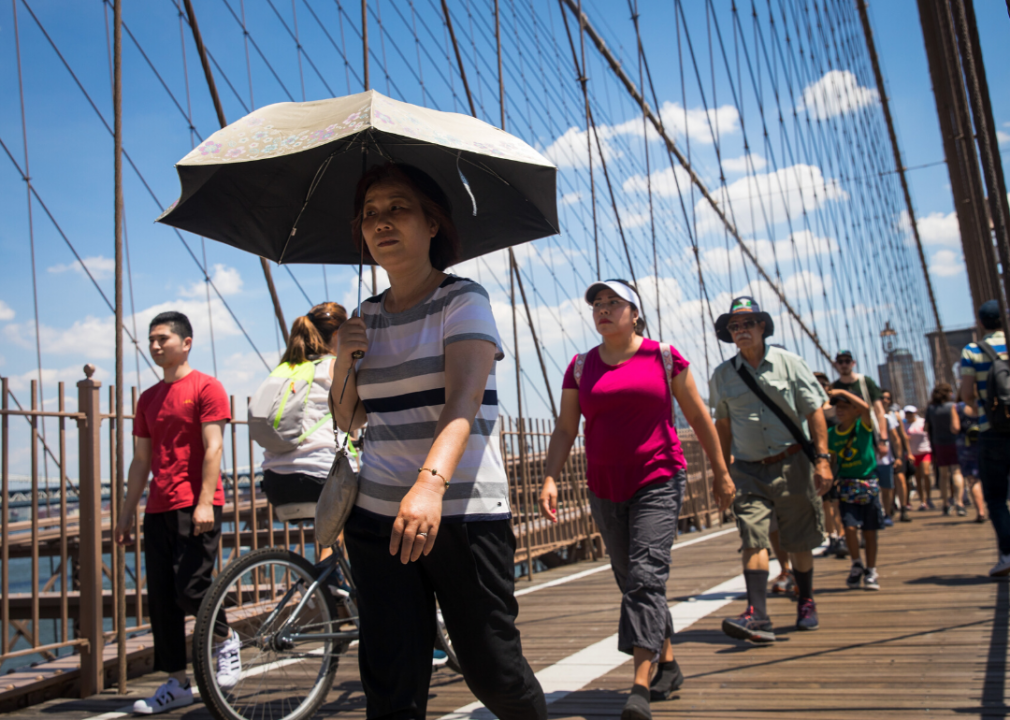
Drew Angerer // Getty Images
2018: Extreme drought, heavy rain
– Average summer temperature: 73.5 F (#6 warmest year; 2.9% above 100-year average)
– Maximum summer temperature: 86.1 F (#11 warmest year; 2% above 100-year average)
– Minimum summer temperature: 60.9 F (#1 warmest year; 4.2% above 100-year average)
– Precipitation: 9 inches (#18 highest; 8.1% above 100-year average)
The summer of 2018 was one of the overall warmest on record. Even so, the high temperatures were accompanied by extensive extreme drought conditions in the West and heavy rain in the eastern United States.

Anna-Rose Gassot/AFP // Getty Images
2019: A cool, rainy Midwestern summer
– Average summer temperature: 72.4 F (#24 warmest year; 1.3% above 100-year average)
– Maximum summer temperature: 84.9 F (#45 warmest year; 0.6% above 100-year average)
– Minimum summer temperature: 59.8 F (#15 warmest year; 2.4% above 100-year average)
– Precipitation: 8.9 inches (#22 highest; 7.1% above 100-year average)
The summer of 2019 was high-average temperature, with an overall pattern of high temperatures on the coasts and a swatch of cooler temperatures down the middle. The central cool area was paired with heavy rain all summer and into the fall.
You may also like: Environmental impact of 20 foods
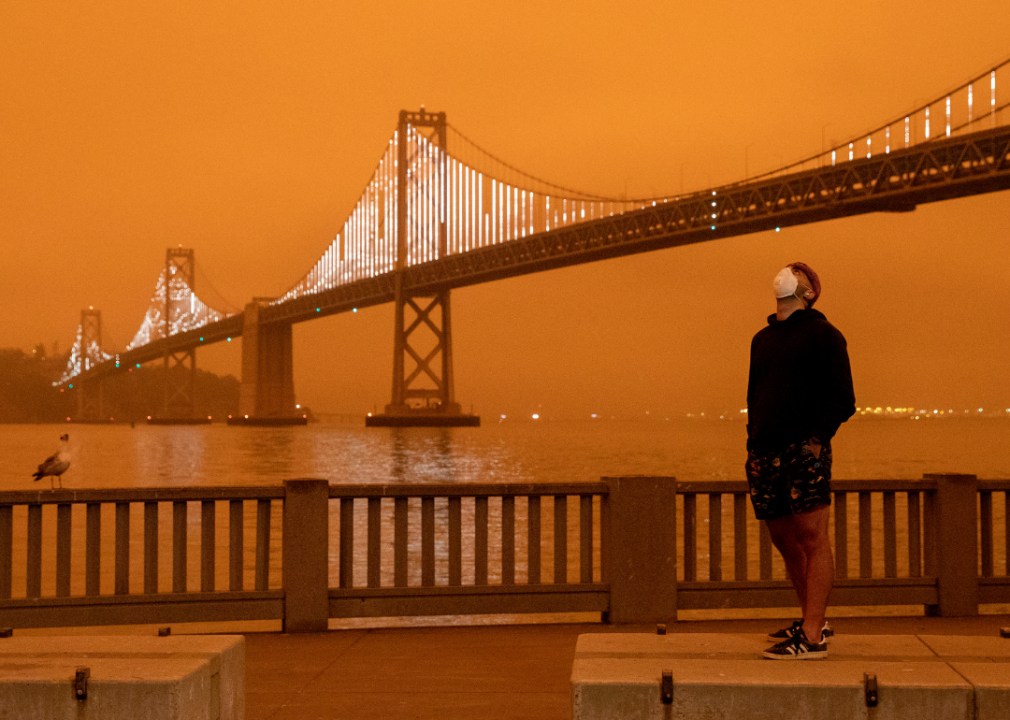
Jessica Christian/The San Francisco Chronicle via Getty Images
2020: Extremes from east to west
– Average summer temperature: 73.5° F (#4 warmest year; 3.0% above 100-year average) – Maximum summer temperature: 86.4° F (#8 warmest year; 2.4% above 100-year average) – Minimum summer temperature: 60.0° F (#13 warmest year; 3.8% above 100-year average) – Precipitation: 8.1″ (#71 highest; 2.6% below 100-year average)
The summer of 2020 was the fourth hottest on record at the time, according to NOAA data. In August alone, the U.S. was battered with hurricanes, extensive wildfires in the West, heat waves, and a strong derecho across the Midwest.
You may also like: States with the most hailstorms




